User:Jafaz/sandbox
| Soviet occupation of Ukraine | |
|---|---|
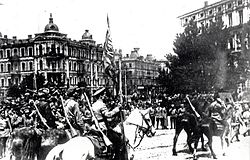 The entry of the Red Army into Kyiv during the second Soviet-Ukrainian War, summer 1920 | |
| 1921–1991 | |
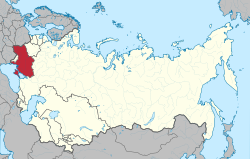 The territory of modern Ukraine under Soviet rule |
The Soviet occupation of Ukraine was a process of military, political, and cultural occupation of Ukrainian lands by the RSFSR / Soviet Union during 1917—1991 after the overthrow of the monarchy in the Russian Empire, which ended with the annexation of the western Ukrainian lands to the USSR in accordance with the agreements of 1939 under the Molotov–Ribbentrop Pact with Nazi Germany. It is characterized by the creation of Bolshevik-Soviet puppet states on its territories — UPRS, UkSSR, GSRR. The process was accompanied by red terror, Holodomors, repressions, deportations, Executed Renaissance, total Russification, and so on. On June 22, 1941, Nazi Germany invaded the Soviet Union and occupied Ukraine. On July 17, 1941, the Third Reich established the Reichskommissariat Ukraine on the territory of Ukraine, headed by Erich Koch. As a result of the Red Army's entry into Ukraine in 1943-1944, the Soviet Union reconquered all Ukrainian territories and returned them to its membership. The Soviet "annexation occupation" of Ukraine lasted until August 1991, when Ukraine regained its independence by adopting the "Declaration of Independence of Ukraine".
Currently in Ukraine, in academic and public discourses, two terms are used to define the Soviet period — радянський, radianskyi and совєцький, sovietskyi. The second term is used to emphasize the alienation of Soviet politics and culture and to downplay the involvement of Ukrainian society in the Soviet Ukraine project.[1] Ukraine remains the legal successor of the Ukrainian Soviet Socialist Republic and not the Ukrainian People's Republic for now, unlike Republic of Estonia, Republic of Latvia and Republic of Lithuania, which are not the legal successors of the Estonian SSR, the Latvian SSR and the Lithuanian SSR.[2][3][4]
Background
[edit]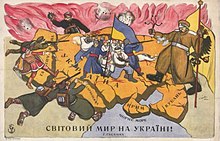
With the overthrow of Emperor Nicholas II of Russia in February 1917, the Pereiaslav Agreement between the Cossack Hetmanate, ie Ukraine, and Tsardom of Moscovy, ie Russia, expired.
After the Bolshevik coup on October 7, 1917, the Ukrainian People's Republic was proclaimed an autonomous republic within the Russian Republic. On January 22, 1918, after the beginning of the Soviet-Ukrainian War, it was declared an independent state.
On the eve of the peace talks in Brest-Litovsk, German experts in international law said that in the event of a peace treaty with Russia, its provisions would apply to Ukraine. The head of the Ukrainian delegation, Vsevolod Holubovych, denied this, setting out the following arguments: an agreement on Ukraine's relations with Russia was envisaged in Pereiaslav; as one of the participants in the conclusion of this act — the Romanov dynasty — remained in the past, it expired along with all Ukraine's obligations to Russia. The German side agreed with the legitimacy of these allegations, and the proclamation of the UPR as an independent state strengthened its status as an equal participant in the negotiations. The Russian delegation, represented by Trotsky, also stated that it "sees no obstacles to the independent participation of the UPR delegation in the peace talks." Thus, in fact, the head of the Russian delegation recognized the right of Ukrainians to self-determination.[5]
Diplomatic relations have been established with more than 20 countries. Until March 1918, the UPR enjoyed the international support of the Central Powers, but after their defeat in the World War I, the UPR was left without their help.
On April 29, 1918, a coup took place, as a result of which Pavlo Skoropadskyi came to power, and instead of the Ukrainian People's Republic, the Ukrainian State was formed. December 14, 1918 as a result of the anti-Hetman uprising of the UPR was restored. On January 22, 1919, the Act Zluky between the Ukrainian People's Republic and the Western Ukrainian People's Republic took place.
On July 15, 1919, Otaman Zelenyi, together with his Pereiaslav soldiers, performed an impressive symbolic act and solemnly annulled the decision of the Cossack Council to unite the Cossack Hetmanate with the Tsardom of Moscovy.[6]
Soviet occupation and annexation (1917—1941)
[edit]Ukrainian People's Republic
[edit]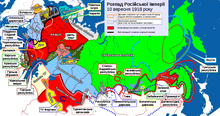
The proclamation of the Ukrainian People's Republic caused dissatisfaction among the Bolsheviks government of the Russian Socialist Federal Soviet Republic in Petrograd, the Council of People's Commissars. On the night of 11 [O.S. 29] December to 12 [O.S. 30] December, 1917, the Bolsheviks tried to revolt in Kyiv against the Central Soviet, but were defeated. Ukrainianized units disarmed their units and expelled them from Ukraine. In response, on 4 [O.S. 14] December, 1917, official Petrograd issued an ultimatum to the Ukrainian government, demanding the cessation of disarmament and, in fact, the surrender of power. At the same time, the Bolsheviks opened the All-Ukrainian Congress of Soviets in Kyiv, at which they planned to take over the Central Rada by re-electing its members and leadership. Despite the pressure, on 6 [O.S. 19] December the congress delegates expressed support for the current Central Rada and its course proclaimed by the Third Universal, and on 7 [O.S. 20] December the Central Rada itself rejected the ultimatum. The plans of the Bolshevik leadership were thwarted and it launched an open war against the Ukrainian People's Republic.
On 9 [O.S. 22] December, 1917, the Red Guard detachments under the command of Vladimir Antonov-Ovseyenko, sent by the Russian government, occupied Kharkiv. On 11 [O.S. 24] December, the Bolsheviks opened an alternative All-Ukrainian Congress of Soviets in the conquered city, which proclaimed the formation of the Ukrainian People's Republic of Soviets with its capital in Kharkiv as the autonomy of Soviet Russia. On 17 [O.S. 30] December, 1917, the governing body of this entity — the All-Ukrainian Central Executive Committee headed by Yukhym Medvedev — issued a manifesto on the overthrow of the Central Rada, lifted the ban on the export of Ukrainian bread to Russia, imposed by the Ukrainian government, and formally called on the Council of People's Commissars. On 7 [O.S. 25] January, 1918, the 30,000-strong Russian Bolsheviks army launched a general offensive against Kyiv.
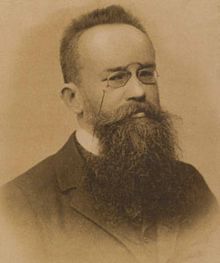
After the Bolshevik occupation of Kharkiv, 24 [O.S. 11] December, 1917, the Ukrainian government addressed the international community with a note stating that it would pursue international relations independently of Russia. 10 [O.S. 28] January, 1918, the Ukrainian delegation, led by Vsevolod Holubovych and later by Oleksandr Sevriuk, joined the peace talks in Brest-Litovsk between the countries of the Quadruple Alliance and the Bolsheviks. Ukrainians sought an end to the World War I on the Ukrainian front. The issue of the entry of Galicia, Bukovina, Carpathian Ruthenia, Chełm Land and Podlachia into the Ukrainian People's Republic, or the formation of national-territorial autonomy from these lands as part of Austria-Hungary was also discussed.
Due to the hostile policy of the Russian leadership towards Ukraine, 22 [O.S. 9] January, 1918, the Central Council adopted the IV Universal. He proclaimed the independence of the Ukrainian People's Republic from Russian Republic and called on Ukrainians to fight the Bolsheviks:
| “ | From now on Ukrainian People's Republic is becoming self-existing, from no one dependent, free, sovereign state of Ukrainian people... we call on all citizens of the independent Ukrainian People's Republic to stand firm in the guarded freedom and rights of our people and to defend their destiny with all our might from all enemies of the peasant-workers' independent Republic of Ukraine..[7] | ” |
On 27 [O.S. 14] January, 1918, Bolsheviks uprisings broke out in Odesa and Mykolaiv. On 29 [O.S. 16] January, 1918, the Battle of Kruty in which the Student Hut of 300 soldiers was defeated by a 4,000-strong Bolshevik detachment. Despite this advantage, the ants lost 350 soldiers, after which 50 student volunteers were taken prisoner. On the same day, a Bolshevik uprising of workers at the Arsenal plant broke out in Kyiv. On 4 [O.S. 23] February, 1918, he was suppressed by soldiers of the Sich Riflemen's Tent and the Free Cossacks. In the face of the Bolshevik threat, on February 2, 1918, the Central Council of Ukraine and its government moved from Kyiv to Vinnytsia. The offensive of the Russian Red Guards from Bakhmach and Luben to Kyiv continued, and on February 8 the Ukrainian government left the capital. On 8 [O.S. 26] February, 1918, Bolsheviks troops under Mikhail Muravyov captured Kyiv, the capital of the Ukrainian People's Republic. Terror against anti-Bolsheviks forces lasted for three days in the city.
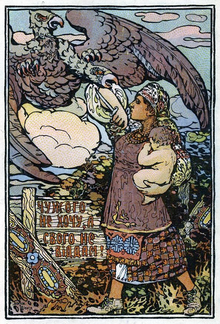
After the conclusion of the Treaty of Brest-Litovsk on February 9, 1918 and the agreement with the German and Austrian governments on the liberation of Ukraine from Bolshevik occupation, the Ukrainian units led by General K. Prisovsky and S. Petliura, together with the German (from 24.02.1918) and Austrian (from 27.02) units led successful battles on the Right Bank near Zhytomyr, Berdychiv, Koziatyn, Bucha and on March 1, 1918 liberated Kyiv. On the night of February 21–22, 1918, Yurko Tiutiunnyk's Zvenyhorod Kish defeated the overwhelming Bolshevik forces at the Bobrynska station.
During March–April, German and Austrian troops liberated the Left Bank of Ukraine, and the military units of Ataman Petro Bolbochan and Volodymyr Sikevych liberated Crimea and Donetsk. Frightened by the German offensive, on March 14, 1918, Lenin instructed his representative in Ukraine, Sergo Ordzhonikidze, to pretend to Ukrainianize the Russian troops of Vladimir Antonov and Muravyov, but this maneuver was unsuccessful. At that time, the battles were fought for railway junctions, and the advance of military units was carried out by battleships on railway tracks. Meanwhile, Soviet Russia was forced to recognize the terms of the Treaty of Brest-Litovsk and later, on June 12, 1918, signed a preliminary peace with the Ukrainian State.
The second phase of the Soviet-Ukrainian War began during the anti-Hetman uprising led by the Directory of the Ukrainian People's Republic. On November 17, 1918, the Provisional Workers' and Peasants' Government of Ukraine was formed in Moscow. On the night of November 18, 1918, the Chernihiv region reported that the Bolsheviks had taken possession of Hlukhiv Povit. On November 19, Soviet troops captured Yampil and the Mykhailivskyi hamlet, squeezing the ring around Hlukhiv; On November 20 to the station Korenevo (now the Kursk region of the Russian Federation). On November 26, the offensive of the Soviet units began in the direction of Mozyr-Kalinkovichi. On December 7, the border guard and the hetman's forces left Novhorod-Siverskyi and moved to Horodnia.
The Directory sent notes of protest against this aggression to the Soviet government (December 31, 1918, March 3, 4, and January 9, 1919). On January 5, 1919, a note was received from Moscow by the People's Commissar for Foreign Affairs of the RSFSR, G. Chicherin, in response to radio telegrams from the UPR government of December 31 and January 3–4. It stated that there were no RSFSR troops in Ukraine, and that the army of the "Ukrainian Soviet government, which is completely independent," was fighting against the Directory. During the war, the Bolsheviks formed a puppet Soviet government of the Ukrainian SSR in the Ukrainian territory occupied by them. Chairman of the Council of People's Commissars of the RSFSR Vladimir Lenin noted that the creation of local Soviet governments in the occupied territories of national republics "takes away the opportunity for chauvinists in Ukraine, Lithuania, Latvia, Estonia to consider the movement of our units as occupation." After the battle for Chernihiv, the Directory declared war on Soviet Russia on January 16, 1919. Between December 1918 and January 1919, Bolshevik troops, with the cooperation of some atamans, occupied the Left Bank, and on February 5, 1919, they approached Kyiv, and the Ukrainian government was again forced to leave the capital. In February 1919, the Bolsheviks led a double offensive: in the north along the line Mozyr-Korosten, Luninets-Sarny-Rivne, trying to distract units of the Army of the UPR from the UGA, and in the south from Kremenchuk-Katerynoslav through Znamianka to Birzula-Zhmerynka, in order to isolate Ukrainian military units from the Entente landing. In this regard, the Army of the Ukrainian People's Republic was defeated, because at some point Otaman Nikifor Grigoriev, dissatisfied with the compliance of the Directory against the Entente, sided with the Bolsheviks. The third Bolshevik group led an offensive from Kyiv in the direction of Berdychiv-Koziatyn-Zhmerynka to prevent the connection between the northern and southern parts of the UPR Army.
During the First Winter Campaign (December 6, 1919 — May 6, 1920), the Army of the Ukrainian People's Republic under the leadership of Mykhailo Omelianovych-Pavlenko operated under the auspices of the Bolsheviks in the Yelisavet region, from February 1920 on the Dnieper in the Zolotonosha region, where it fought with the 14th Soviet army.[8] After the signing of the Treaty of Warsaw (April 22, 1920), the Polish-Ukrainian offensive against the Bolsheviks began. The Polish army and two Ukrainian divisions, as well as the army returning from the Winter Campaign, launched an offensive against the Bolsheviks. As early as May 7, 1920, Marko Bezruchko's division, together with Polish units, entered Kyiv (the Kyiv operation of the Polish army). However, these initial successes were offset by the counteroffensive of the Bolshevik army of Semyon Budyonny, who in June–August gained territory near the river Zbruch, and later occupied most of Galicia and Volhynia and went to Warsaw via Zamość. After the defeat of the Bolsheviks near Warsaw (September 15, 1920), another offensive by Polish-Ukrainian armies began, which, having pushed back the Bolshevik troops, reached the Yaruha (above the Dniester) — Sharhorod — Bar — Lityn line in Podillia. These operations were stopped on October 18, 1920, when the Polish government signed a truce proposed by the Russian side. At that time, the UPR Army, numbering 23,000 soldiers, continued to fight against the Bolshevik troops until November 21, 1920, when, under pressure from the prevailing troops, Zbruch had to move to the territory of the Polish state, where it was interned.
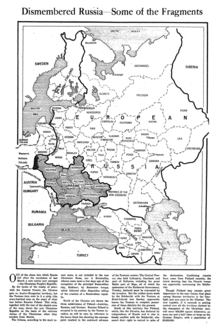
The last armed demonstration of volunteers among the UPR soldiers interned in Poland against the Bolsheviks, under the command of General Yu. Tiutiunnyk, took place in November 1921. The task of this so-called Second Winter Campaign was an underground raid against the Bolsheviks to coordinate guerrilla units. of the Soviet regime in Ukraine. Organized three groups: Podolsk (400 fighters), Volyn (800 fighters) and Bessarabian (up to 300 fighters) crossed the Soviet border and operated on the Right Bank. On October 25, the Podil group crossed Zbruch near Husiatyn, fought successfully in Podillya and reached the village of Vakhnivka in Kyiv region, from where she returned via Volyn to the Polish border and crossed it on November 29. The Volyn group crossed the Soviet border on November 4, captured Korosten on November 7 and reached the village of Leonivka in Kyiv region, but without joining the Podolsk group, also moved to the West. Surrounded by G. Kotovsky's cavalry, the Volyn group was defeated in the battle near Maly Minki (November 17), and 359 captured soldiers were shot on November 21, 1921 near the Bazaar. 150 soldiers from the Volyn group broke through to the Polish border.
On March 18, 1921, after the "miracle on the Vistula" and the catastrophe of the Red Army of the RSFSR, the USSR and Poland signed the Peace of Riga, according to which the territory of Ukraine was divided by the river Zbruch. The UPR government was not allowed to negotiate. The Western Oblast of the Ukrainian People's Republic government was soon formally dissolved, and the UPR government went into exile until restore Ukraine's independence when UPR President Mykola Plaviuk handed over a letter from the UPR State Center to President Leonid Kravchuk that Ukraine, proclaimed on August 24, 1991, is the legal successor of the Ukrainian People's Republic.
After the unsuccessful end of the war by regular units of the UPR army, guerrilla units took up the cause. For several more years, a guerrilla struggle against the Bolshevik government was waged, mainly on the Right-bank Ukraine. The commanders of the insurgent units, who were not formally subordinate to the Ukrainian military leadership, which was already in exile at the time, continued to hope for a new general military shift that would free Ukraine from Soviet occupation.
On December 30, 1922, the RSFSR, the UkSSR, the BSSR, and the TSFSR concluded an agreement on the formation of the Union of Soviet Socialist Republics. However, the agreement was not ratified and signed with the RSFSR.[9][10][11] The leadership of Soviet Ukraine did not essentially sign the agreement with Soviet Russia, the final text was not drafted, and it did not become an international agreement. The claim that the First Congress of Soviets of the USSR created the Union of Soviet Socialist Republics is untrue. Instead of the approved procedure of the interstate agreement, an internal document was formed — the Constitution of the USSR of July 6, 1923. Which indicates the lack of legitimate grounds for the international formation of the USSR.[9][10][11]
Western Ukrainian lands
[edit]
After the collapse of the Austro-Hungarian Empire, the leadership of the RSFSR saw the Western Ukrainian People's Republic as a possible springboard for the spread of communist ideology and power further west to Central Europe. Lenin wanted the Red Army to pass through the territory of western Ukraine and the Carpathians to Hungary after the proclamation of the Hungarian Soviet Republic in April 1919. On May 7, the Soviet of People's Commissars of Ukraine sent a note to the government of the Western Ukrainian People's Republic, to which the Western Ukrainian government decided not to respond.[12] In the summer, after the retreat of Western Ukrainian troops under pressure from the Poles, the commanders of the Galician army held secret talks with the Soviet command about a possible alliance against the Poles, but to no avail.[12]
During the Polish–Soviet War of 1920, the leadership of the RSFSR created the Galician Soviet Socialist Republic as a political structure and a springboard for further communist exodus to the West. At the end of July, the Red Army occupied the territory of Galicia, and on August 1, Galrevkom moved to Ternopil, where it passed Decree No. 1 "On the Establishment of Soviet Power in Galicia." In the evening of September 15, the general offensive of the Active Army of the Ukrainian People's Republic on the line of the anti-Bolshevik front began. On September 19, the forces of the 6th Polish Army and the Active Army of the Ukrainian People's Republic entered Ternopil, and on September 21, the post-factum dissolution of the Galrevkom and the Air Committees took place. The Galician SSR was the last of the puppet Soviet republics established outside the former Russian Empire.[13]
The hostilities on the Polish-Soviet front were stopped after the armistice was concluded on November 9, 1920 by the Polish and Bolshevik leadership. However, the next day near Sharhorod, the Red Army insidiously counterattacked Ukrainian divisions, breaking through the front in the direction of Kopaihorod on the right wing held by the 5th Kherson Division of the UPR Army, and in the direction of Luchynets, where the 2nd Iron Division and Machine Gun Division were located. UNR. On November 15, the Red Army entered the Podolsk town of Lityn. On November 18, the Red Army entered Proskurov and Derazhnya station, and on November 20, it entered Chorny Ostrov and Letychev. After two weeks of bloody fighting due to lack of ammunition and military equipment, they were forced to retreat to Galicia on November 21. The crossing of the Active Army of the Ukrainian People's Republic — up to 27,000 soldiers — across the Zbruch River took place near Volochysk and the village of Ozhyhivtsi. On the same day, in accordance with the terms of the preliminary Polish-Soviet treaty, Polish troops left the city of Novohrad-Volynskyi. On November 22, Soviet troops entered Volochysk.
In March 1921, the Riga Peace Treaty of 1921 was signed in Riga between the Second Polish Republic, on the one hand, and the RSFSR and the UkSSR, on the other, which established the incorporation of eastern Galicia into the Republic of Poland. However, it is not known how the members of the Soviet delegation represented Ukraine's interests in these negotiations, as the content of the treatise in Ukrainian was to be written by Leon Wasilewski, a representative of the Polish delegation. Interestingly, on September 12, in response to a request from the Minister of Foreign Affairs of the Republic of Poland for the participation of the UPR delegation in the Riga Conference, the People's Commissar for Foreign Affairs of the RSFSR replied:
| “ | The Ukrainian Democratic Republic does not exist at all, as Ukraine is an independent Soviet Republic, allied with Russia, and participates with it in the negotiations in Minsk and Riga. | ” |
On September 16, the UPR government published its note of protest against the statement of the People's Commissar for Foreign Affairs of the RSFSR of September 12 regarding the UPR.
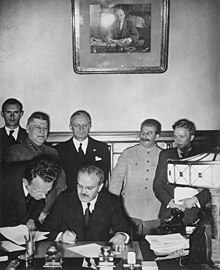
On September 17, 1939, they crossed the Polish state border under a secret point of the Molotov–Ribbentrop Pact between the Soviet Union and Nazi Germany, occupying Ukrainian territories in order to allegedly "protect" the Ukrainian and Belarusian minorities during the collapse of the Polish state. Immediately after crossing the Soviet-Polish border, military political bodies launched an active propaganda campaign. Local political, intellectual and creative elites were wary of the arrival of the "Soviets". The People's Assembly unanimously voted to thank Stalin for his release and sent a delegation led by Studynsky to Moscow (because it was there, in the Kremlin, and not in Kyiv, that the future of Western Ukraine was actually decided) to request the official inclusion of the territories in the USSR. The Supreme Soviet of the USSR voted for this decision on November 1, 1939, when the V Extraordinary Session of the Supreme Soviet of the USSR adopted the USSR Law "On the Inclusion of Western Ukraine into the USSR with its Reunification with the UkrSSR."[14]
This state act provoked a mixed reaction even among the Red Army. Here is how a fighter of the 170th Rifle Regiment of the 58th Division of the Ukrainian Front Rasevych reacted to the story of an army agitator about crying from happiness of a peasant from Western Ukraine after the adoption of this law:
| “ | They are crying with one eye, but when the Soviet authorities press them, they will cry with both[15] | ” |
Only half a month later, on November 15, Kyiv passed its own law, which, following Moscow, confirmed this inclusion: the third Extraordinary Session of the Verkhovna Rada of the USSR decided: “To accept Western Ukraine into the Ukrainian Soviet Socialist Republic and thus reunite the great Ukrainian people. the only Ukrainian state".[16] The lands seized by the USSR in Poland were administratively reorganized into six oblasts by analogy with the rest of the Soviet Union (Drohobych, Lviv, Rivne, Stanislav, Ternopil, and Volyn oblasts). The civil administration in the regions annexed by Poland was organized in December 1939 and formed mainly of Russians, and only 20% of civil servants came from the local population. After the Soviet invasion of Poland, more than 30,000 Ukrainian intellectuals and national activists hastily left Galicia in various ways, seeking refuge on the western outskirts of ethnic Ukrainian lands in Poland (Trans-Curzonia), who found themselves on the other side of the new Soviet-German border within the General Governorate.[17]
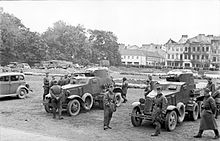
Beginning in April 1940, the Soviet authorities in the annexed territories began to spread their repressive measures against the entire Ukrainian population, their culture and religion.
On June 26, 1940, Soviet People's Commissar for Foreign Affairs Vyacheslav Molotov handed Romania's ambassador to Moscow, George Davidescu, a note from the Soviet government urging[18] the Soviet Union to return Bessarabia and northern Bukovina to the Soviet Union. Romania quickly agreed to withdraw from these territories to avoid a full-scale military conflict. Despite the fact that Soviet propaganda called the protection of the large Ukrainian community the reason for the Romanian campaign, the policy changed after the occupation of the territory. It was no longer a question of the annexation of lands and inhabitants to the USSR and its population, but of the return of the territory of the "motherland of the USSR" at the same time to the number of "one-blooded brothers." On August 2, 1940, by the decision of the Supreme Soviet of the USSR, these territories became part of the Soviet Union: Northern Bukovina, Southern Bessarabia and the Hertza region became part of the USSR. After the Nazi occupation by the Third Reich, all these regions were again occupied by the Red Army and reintegrated into the USSR in 1944.
Crimea
[edit]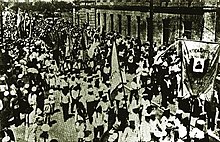
The civil war on the territory of Crimea began in early 1918 — fighting between the SNP troops (the main armed forces of which were created during the Provisional Government national units of the Crimean Tatars) and Bolshevik units took place in Yalta, Evpatoria, Simferopol and other Crimean cities. By mid-January 1918, hostilities of a bright national color (Russians, supporters of the Soviets, against the Tatars, supporters of the regional government) were already going on throughout the peninsula.
In January 1918, the Black Sea Fleet and the largest city in the Crimea, Sevastopol, were under Bolshevik control. Following the example of Sevastopol, the Bolsheviks began to form Military Revolutionary Committees (MRCs) throughout the Crimea. By secret oral order of the government and the Ministry of Military Affairs of the Ukrainian People's Republic, on April 10, 1918, Ukraine launched the Crimean operation. General Alexander Natiev was to separate a separate group from the corps, equipped with all kinds of weapons as a division under the command of Colonel Bolbochan. In the evening of April 22, 1918, the Crimean group captured the city of Dzhankoi, the first hub station in the Crimea, which gave it the opportunity to launch a further offensive. Here all the forces of the marching group were concentrated and began to move forward in three parts: the first part, consisting of infantry, armored vehicles and artillery, moved along the eastern side of the railway on the route Dzhankoi-Simferopol, the second part (Hordiienko Regiment and cavalry artillery division) moved in the direction , and the third part went to Teodosiia.[19] The main forces of Bolbochan's group were directed to Simferopol, which was captured almost without resistance on the morning of April 24, 1918. Around the same time, the Hordiienko Regiment captured Bakhchisarai.
On April 26, 1918, the 15th German Division, by order of General von Kosch, surrounded all the locations of Ukrainian troops and the main strategic points of Simferopol. An ultimatum was issued to Colonel Petro Bolbochan to immediately lay down his arms, leave all military property and leave the city and territory of Crimea under the protection of a German convoy as internees, disbanding the volunteer detachments. Explaining the reason for his demands, General von Kosch stated that according to the terms of the Treaty of Brest-Litovsk, Crimea does not belong to the territory of Ukraine and there are no grounds for the Ukrainian army to stay on this land.
On April 27, 1918, the Minister of Military Affairs of the Ukrainian People's Republic, Oleksandr Zhukivsky, ordered by telephone the immediate withdrawal of the Zaporizhzhya Division from the Crimea, which was announced in the presence of General von Kosch. Ataman Oleksandr Natiev was dissatisfied with the fact that he had left the group conducting the military operation in Donbas, and General von Kosch was told that a previous statement by the UPR government claiming that there were no Ukrainian troops in Tavrida was "simply a misunderstanding." As a result, the Crimean group of the Ukrainian army, which was threatened with disarmament by the Germans, was withdrawn from Tavrida and located near Oleksandrivsk.[20]
After the armistice with Poland on the Polish front, the Soviet government regrouped its armies and focused on capturing Crimea. On September 21, 1920, the Southern Front was formed under the command of Mikhail Frunze, who was tasked with "preventing a new winter campaign." On November 11, 1920, when the Whites were driven out of the Ishun positions, the Commander-in-Chief and Ruler of Southern Russia, Pyotr Wrangel, issued an evacuation order. On November 13, 1920, units of the 2nd Cavalry Army entered Simferopol, and by November 17, 1920, all Crimean cities were under Bolshevik rule.[19]
Red terror
[edit]
In Ukraine, the Red Terror began in January 1918 with the invasion of the Red Guard detachments of Muravyov, who staged a massacre in Kyiv during and after the storming of Kyiv. According to various estimates, the victims of the massacre were from 2 to 3 thousand people.[21] From that moment on, violence and terror became the main methods of establishing Soviet power here. According to V. Korolenko, arrests and extrajudicial executions of political opponents under the pretext of fighting the counterrevolutionaries have become a common, "domestic phenomenon" of Soviet reality.[22]
The actions of the Red Guards in Ukraine were particularly brutal. For example, the Kharkiv Cheka used scalping and "removing gloves from the hands", in Poltava and Kremenchug priests were put in circles. In Yekaterinoslav crucifixion and stoning were used, in Odesa officers were chained to boards, inserted into fireboxes and fried, or winches were torn in half by wheels, or lowered alternately into a cauldron of boiling water and into the sea.[23]
There is a large group of press materials about the activities of the VNK or the Red Terror of the Bolsheviks in Ukraine in 1919. About the shootings in Kyiv, Kharkiv, Vinnytsia, Zhytomyr and other cities of Ukraine, the victims of "emergency", as this commission was popularly called, testified almost all periodicals in Ukraine. Jewish pogroms in Ukraine were a phenomenon that no newspaper could pass.[24] The victims of Bolshevik terror in Kyiv, Odesa and other cities were: Rector of the Ukrainian Academy of Arts Oleksandr Murashko, writer Dmytro Markovych, poet Hryhorii Chuprynka, composer Mykola Leontovych, actor and writer Olelko Ostrovskyi and thousands of others, the Ridne Slovo newspaper wrote in an article "Victims of" emergency "among Ukrainians".[25][26][27]
Other newspapers cite the facts of the activities of the VNK in Ukraine, according to the Main Liquidation and Investigation Commission, which was established under the Government of the Directory in 1919.[24] Thus, in the notes "Victims of Bolshevism" and "Excavations of graves shot by the Bolsheviks", the newspaper "Citizen" indicated that "according to rough estimates, up to 3,000 people were shot dead by the Bolshevik" emergency "in Vinnytsia." The newspaper Trudova Hromada and other publications also inform about the shootings in Kyiv and the resolutions of the Kyiv provincial "emergency".[28]
Among the victims of the Red Terror of the end are many famous figures. On January 23, 1921, the Ukrainian composer Mykola Leontovych ( He is recognised for composing Shchedryk in 1904, which premiered in 1916, known to the English-speaking world as Carol of the Bells or Ring, Christmas Bells) was assassinated as an agent of the VNK, and in August 1921 the Russian poet Nikolay Gumilyov. Russian scientist Konstantin Tsiolkovsky was under arrest by the Cheka for three weeks.
In 1929, a fabricated trial began against the fictional Union for the Freedom of Ukraine. Forty-five leading scholars, writers, and other intellectuals, including Serhii Yefremov, Volodymyr Chekhivskyi, Andrii Nikovskyi, Yosyp Germaize, Mykhailo Slabchenko, Hryhoriy Holoskevych, and Liudmyla Starytska-Cherniakhivska were accused of belonging to a secret nationalist organization called the Union for the Liberation of Ukraine. The goal was attributed to the "discovered" organization: with the help of foreign states, emigrant forces, incitement of the peasantry against collectivization, the assassination of Stalin and his allies, to separate Ukraine from the USSR.
Deportation of Ukrainians
[edit]In 1925-1928 the so-called tripartite commission of the UkSSR, BSSR and RSFSR on the redistribution of borders carried out work, and as a result of the work of that commission and the division of borders from the Ukrainian lands of Starodub, Belgorod, Orlov, Don were deported to Green, Raspberry and Gray Ukraine.
In 1930, the USSR began clearing the western borders — and again the deportation of Ukrainians. The so-called "kurkul" expulsion of 1930-36 again took tens of thousands of Ukrainians.
With the capture by the Soviet Union of Western Ukraine, Western Belarus, and the Baltic States in 1939-1940, the deportations also affected the peoples who lived in these lands.
As early as the fall of 1939, the first wave of deportations engulfed the Polish Osadnik, who were evicted with their families. Between December 1939 and March 1940, more than 137,000 people were deported from Western Ukraine and Western Belarus. They were deported to the north-eastern regions of the RSFSR, the Komi Autonomous Soviet Socialist Republic and Kazakh Soviet Socialist Republic.
The second wave of deportations took place in April 1940, when wealthy peasants ("kurkuliv") (up to 6,000 families from Western Ukraine and Western Belarus) were deported. In 1939-1940, a total of 10 to 20 percent of the population was deported from Western Ukraine to Siberia, the Volga region, Kazakhstan, and the North. Many innocent people caught in the German prisons during the German-Soviet war were killed.[29]
In Western Ukraine, in June 1941, the NKVD carried out another, for the fourth time in two years, deportation from Western Ukraine, which covered more than 300,000 people.[30][31]
In Northern Bukovina, deportations took place in two stages — the first took place on May 23, the second — on June 13, 1941. In May, the so-called traitors of the Motherland, convicted by a special meeting of the NKVD of the USSR, were deported. This category included those who sought to go abroad or attempted to cross the border illegally,[32] as well as members of the OUN.[33] 181 Bukovinian families (306 adults and 210 minors) were subject to deportation. In 36 cars they were sent to the Kirov region, Krasnoyarsk Territory and the Komi Autonomous Soviet Socialist Republic.[33] In June, according to the resolution of the joint meeting of the bureau of the Chernivtsi regional committee of the CP(B)U and the regional executive committee of June 8, 1941, "landlords, manufacturers, activists of counterrevolutionary parties, and large merchants" were added to the "traitors of the homeland."[32] As a result of the June action, 2,279 families were evicted from Bukovyna — 7,116 people, another 604 people were arrested.[33]
The Holodomor of 1921—1923
[edit]During the Russian intervention in 1919, looting of peasants began in the villages, and confiscated grain and cattle were exported to Russia. Alexander Schlichter, the Bolshevik commissar at the time, wrote that 8.5 million poods of bread had been taken from Ukraine instead of the 50 (which the Bolsheviks had hoped for). Against this political and violent background of state terrorism, famine developed. Its spread was also facilitated by drought and crop failure, which in 1921 covered the most important grain regions of Russia — the Volga region, the North Caucasus, and in Ukraine its southern steppe regions. In the south of Ukraine in the autumn of 1920, in the winter and in the spring of 1921 only 3/4 of the usual norm of precipitation fell. The catastrophic situation was in Ekaterinoslav, Donetsk, Zaporizhzhia, Odesa, Mykolayiv and Kharkiv regions. At the expense of the northern and right-bank areas, which suffered less from the crop failure in Ukraine, 300 million poods of grain or 30% of the 1916 harvest were harvested.
The government of the Ukrainian People's Republic in exile began declaring famine in Ukraine in the autumn of 1921. Thus, in September 1921, the plenipotentiary representative of the Ukrainian People's Republic, Oleksandr Shulhyn, appealed to Nansen for help to the starving Ukrainian population, and a month later the UPR mission raised this issue in Paris. Unfortunately, then the Western world did not care about the tragedy of the Ukrainian peasantry. And at the beginning of January 1922 the number of starving people here reached 1,890,000, in March — 3,250,000, in June — 4,103,000.[34] A spokesman for Nansen's subsidiary, Captain W. Quisling, an eyewitness to the famine, testified in a telegram in February 1922 that "about 7 million people in Ukraine are starving to death in all the horrible sense of the word." This, by the way, was emphasized by Quisling, without other Ukrainian territories, to which he referred, first of all, Kuban.
On May 12, 1921, Lenin signed a telegram from the SNK of the USSR to Kharkiv, demanding that measures be taken to send at least 1 million poods of bread to the central provinces of the RSFSR during May 1921.[35]
On August 6, 1921, Lenin exchanged telephone messages with the People's Commissar of Food of the USSR, M. Vladimirov, in Kharkiv. The instruction to sell salt exclusively in exchange for bread and only to those peasants who paid at least 1/4 of the input tax was given. On August 9, the SNC of the USSR adopted a resolution "On the order of transportation of products by rail and waterways", it was noted that the composition of 3 poods of products allowed for transportation by passengers could include: no more than 10 pounds of salt and 5 pounds of sugar.
On September 20, 1921, the Politburo of the Central Committee of the CP (B) U approved a plan for the export of food for the RSFSR in the amount of 57 million poods, with the proviso that in two months the planned task should be increased. On September 23, having no leverage to influence the real state of affairs, the SNC of the USSR adopted a resolution declaring part of Ukraine a territory of state procurement for trade and declaring Chernihiv, Podil, Poltava, Kyiv and Kremenchug provinces territory of state procurement of bread, grain and fodder.[36]
The Politburo of the Central Committee of the CP (B) U makes a special decision to provide rations to the Communists in the starving provinces. And funds for this are allocated from the state budget, which has already accounted for valuables from looted churches at the behest of the Central Committee. Non-communists from the starving regions were not assisted. At the same time, the leaders of the Communist Party are organizing sanatoriums in Germany and accounts in Swiss banks.[37] On October 7 or 8, 1921, Lenin signed draft resolutions and resolutions of the Labor and Defense Council of October 7, 1921, on the export of 57 million poods of bread from the USSR. On October 12, 1921, the Politburo of the Central Committee of the Communist Party (b) extended to the territory of the USSR all resolutions of the Central Committee of the RCP (B) on executions. November 11, 1921 in the Zaporozhye province conducted a census of starving, according to preliminary data, about 175 thousand people went hungry, the population ate surrogates, mostly cake; 7 parishes of Zaporizhia district, 5 of Melitopol district, 2 of Huliaipil district suffered the most from the famine. On December 19, authorities reported that up to 35,000 people were on hunger strike in the Upper Dnieper district of Odessa province, and about 75% of the population was on hunger strike in 11 districts of Ekaterinoslav province.
October 7, 1922 in Kharkiv, a commission sent by the All-Ukrainian Central Executive Committee to investigate the situation in the starving areas (chairman V. Yermoshchenko): the situation in the starving areas, except for Odessa district, will be more difficult than last year. By mid-October 1922, 200,000 people were starving in the Ekaterinoslav province, including 96,000 children, and 40,000 peasant farms needed seed assistance. Four counties begged for immediate help. According to a special report on November 15, 1922, 500,000 people went on a hunger strike in the Donetsk province, a quarter of them in Mariupol County, and the American aid administration worked exclusively in Mariupol County, where it fed 11,000 children; according to the provincial commission for aid to the starving, half of the starving were doomed to starvation.
On January 3, 1923, at the suggestion of Chicherin, People's Commissar for Foreign Affairs of the USSR, the USSR government offered the Soviet press and newspapers receiving subsidies from the USSR government to temporarily refrain from publishing news about Ukraine until the end of the Lausanne Conference and Chicherin's return from abroad. , The North Caucasus and the Crimea. For many decades, Soviet school textbooks claimed that in the early 1920s, famine affected only the Volga region. This was announced then and before the Western world, from where Lenin and his associates asked for food aid in the region. Moscow was silent about the fact that the same famine spread throughout southern Ukraine, from where bread was exported en masse to northern Russia and for export.
The Holodomor of 1932—1933
[edit]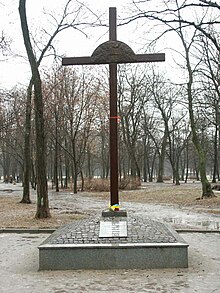
From the documents known at present (in particular[39]) it follows that the leadership of Soviet Russia (later the USSR) deliberately organized the extermination of Ukrainians by starvation. The famine was organized in all their ethnic lands, not only within the USSR. The organizational actions and open plunder of the peasants, which caused famine among the peasantry, with the use of troops, began no later than 1920, from the time when Ukraine was, as it is now openly written, "conquered by the Red Army in 1920."[40] Both the first organizers and leaders of these actions were V. Ulyanov-Lenin and L. Trotsky.
On April 19, 1932, the Politburo of the Central Committee of the All-Union Communist Party (Bolsheviks) adopted a resolution "on a seed loan to Ukraine." As an exception, the loan was granted without interest, but from "centralized resources within Ukraine." The state confiscated grain and then allowed the use of grain harvested in the Ukrainian SSR for the needs of the Ukrainian SSR without attracting external resources. As much as 12 thousand tons and only 3 thousand tons for food aid to collective farmers. On August 7, 1932, a resolution of the Central Executive Committee and the SNC of the USSR "On the Protection of the Property of State-Owned Enterprises, Collective Farms, and Cooperatives and on the Strengthening of Public (Socialist) Property" appeared, known as the Law of Three Spikelets. Theft of collective farm property was punishable by execution, and under "mitigating circumstances" — imprisonment for a term of at least 10 years. The Five Ears Act actually barred people from owning food. As of September 14, after the adoption of the law of August 7 (the Law on Five Ears), the People's Commissariat of Justice of the USSR stated in a report about 250 sentences for executions.[41]
On December 1, the Soviet People's Commissar of the UkSSR banned the sale of potatoes in areas that do not fulfill the obligations of contracting and checking the available funds of potatoes in collective farms. On December 3, trade in meat and animals is prohibited in a number of districts. On December 6, these districts, as well as individual villages, began to be blacklisted.[42] Subsequently, the villages were completely isolated from the outside world. On December 11, the leadership of the UkSSR received a cipher of V. Molotov and J. Stalin with a demand to "immediately try and give five, preferably ten years in prison" for non-fulfillment of grain procurement plans by collective farms and peasants.[43][44]
On January 16, 1933, the Politburo of the Central Committee of the All-Union Communist Party (Bolsheviks) approved the final plan for grain procurement for Ukraine — 260 million poods without mirchuk, which was subject to "unconditional and full execution" and "at any cost." After the introduction of all these measures and restrictions, by the beginning of 1933 most of the peasants of Ukraine were left without food. January 22, 1933. Directive of the Central Committee of the CPSU (b) and the SNC of the USSR "On the prevention of mass exodus of starving peasants": it was forbidden to leave the territory of Soviet Ukraine and the Kuban.
In the spring of 1933, the peasants were taught to work in the public economy by organizing food outlets in the fields. To do this, the state has allocated part of the previously selected grain. In order to improve life in the village affected by the famine, emergency bodies of the Communist Party dictatorship were organized — political departments of MTS and Sovkhoz. In the USSR, the very fact of mass starvation deaths was silenced by the communist regime and even carefully concealed. The Kremlin leadership has banned government agencies and institutions from documenting the true cause of starvation.[45]
On September 27, 1933, Oleksandr Shulhyn, a representative of the UPR Government in exile, addressed a letter to the 14th Assembly of the League of Nations, drawing the world's attention to the famine in Ukraine. As a sign of protest against the actions of the USSR government and to draw the attention of the world community to the tragedy of Ukraine, the OUN organized an assassination attempt on the USSR consul in Lviv. Mykola Lemyk, a 19-year-old high school student, volunteered to carry out the OUN sentence. On October 21 (October 22), 1933, he shot dead the head of the office of the USSR consulate in Lviv, Alexei Maylov (GPU emissary, personal representative of J. Stalin). An immediate trial in Lviv in October-November 1933 sentenced Lemyk to death. After some time, the death penalty was commuted to life imprisonment. The leadership of the CPSU (b) and the government of the USSR refused any assistance from abroad to the starving in Ukraine. At the request of the Ukrainian Trade and Credit Organization of Galicia "Tsentrospilka" to the Soviet consul in Lviv with a proposal to allow the starving people of Soviet Ukraine to send one million quintals of grain, a few days later a categorical refusal was received from Moscow.[46]
During the international scientific-practical conference "Holodomor of 1932-1933: losses of the Ukrainian nation", which took place on October 4, 2016 at the Taras Shevchenko National University of Kyiv, the conference decided to consider scientifically established losses from the Holodomor-genocide of 1932-1933 at least 7 million — in the USSR and 3 million — outside the USSR: in the Kuban, Central Chernozem region, Volga region and Kazakhstan.[47]
Executed Renaissance
[edit]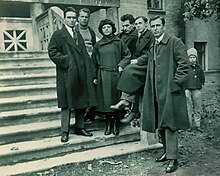
On May 12-13, 1933, the Executed Renaissance began, when Mykhailo Yalovyi was arrested and Mykola Khvyliovyi committed suicide, in the bad memory of the Slovo Building in Kharkiv. The culmination of the Soviet repressive regime was the mass executions of "counter-revolutionaries" on the eve of the 20th anniversary of the October coup. Thus, on November 3, 1937, a large group of prisoners of the Solovetsky prison was executed in the Sandarmokh tract (Karelia) by the decision of the troika. The list of "Ukrainian bourgeois nationalists" shot on November 3 included Les Kurbas, Mykola Kulish, Matvii Yavorskyi, Volodymyr Chekhovskyi, Valerian Pidmohylnyi, Pavlo Fylypovych, Valerian Polishchuk, Hryhorii Epik, Myroslav Irchan, Marko Voronyi, Mykhailo Kozoris, Oleksa Slisarenko, Mykhailo Yalovyi and others. In total, dozens of representatives of the Ukrainian intelligentsia, the color of the Ukrainian nation, were executed in one day by the decision of non-judicial bodies.
Exact data on the number of repressed Ukrainian intellectuals during the Stalinist repressions of the Shot Renaissance period are not known. According to some estimates, this number reached 30,000 people.[48]
Persecution of religions
[edit]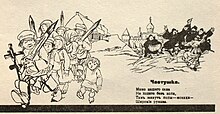
According to the CEC decision of July 20, 1921, Agitprop and its national branches were to begin comprehensive anti-religious propaganda. An anti-church commission was set up within the propaganda subdivision of the Central Committee's propaganda department to coordinate the anti-religious struggle. The commission consisted of officials from Agitprop, the Moscow Committee of the RCP (B), the VIII Liquidation Division of the People's Commissariat of Justice, the Central Committee of the RKSM of the Communist Youth Union, and the People's Commissariat of Education and the Main Political Directorate.
After a short period of tolerance for the Ukrainian Autocephalous Orthodox Church, the Bolsheviks launched a terror against it. The circular of September 4, 1926, "On Ukrainian Separatism," proclaimed the "Ukrainian Autocephalous Church a powerful stronghold of nationalism and an excellent propaganda tool." On February 25, 1926, the Politburo of the Central Committee of the Communist Party of the Soviet Union (Bolsheviks) in a closed session approved a decision on repression against UAOC activists. According to the GPU of the Ukrainian SSR, 214 UAOC priests were former servicemen of the UPR army, 55 were members of Ukrainian national parties, 46 were former tsarist officers, 22 were White Guards, and 17 were gendarmes and policemen. By February 1926, according to the GPU, 59% of the UAOC clergy (331 people) were in "hostile positions," and 70% of parishes were campaigning. In 1925 there were 989 parishes of the UAOC in the USSR (680 thousand parishioners). After the removal (on the instructions of the GPU and through its agency in the UAOC) of V. Lipkovsky and his supporters from the leadership of the UAOC at its Second All-Ukrainian Church Council in October 1927, the apex of autocephaly became completely under the control of the Chekists. On January 29-30, 1930, 40 bishops at the Extraordinary Congress announced the dissolution of the UAOC for "counterrevolutionary activity," declaring at the same time Vasyl Lipkivskyi a "Jewish trader." The metropolitan lived the rest of the years before the execution in the suburbs of Kyiv, in poverty, under the constant supervision of the GPU — NKVD, wrote "History of the Ukrainian Church" and sermons, corresponded with Ukrainian churchmen abroad, made Ukrainian translations of liturgical literature.
At the beginning of 1929, a top-secret circular "On Measures to Strengthen Anti-Religious Work" was sent out, equating the struggle against religion with a class-political one, which opened a new stage in the attack on religion.[49] In May 1929, the XIV All-Russian Congress of Soviets adopted a new version of Article 4 of the Constitution of the RSFSR: instead of "freedom of religious and anti-religious propaganda" recognized "freedom of religious confession and anti-religious propaganda", which legally put believers unequal with other citizens.
Since a number of religious buildings were closed in the late 1920s and 1930s, many religious objects were seized. Some of these items were made of precious metals. Many items came to the museum, where they are preserved. Some items remained in the hands of the population, who tried to hand over cult objects made of precious metals in Torgzin. Historian Olena Osokina notes that Torgzin was not allowed to accept church property, as it was legally considered state property and subject to confiscation (however, Osokina cites examples of this ban being violated by Torgzin employees who took money for church property).
During the war of 1941-1945, the political leadership of the USSR finally abandoned plans to destroy religion and the church as soon as possible and switched to a policy of partial revival of religious life in the country under strict state control.
German occupation (1941—1944)
[edit]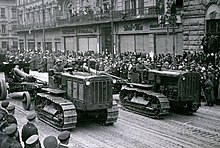
On June 30, 1941, after the retreat of Soviet troops from the city of Lviv, the first Wehrmacht units entered it on the morning of the same day, the Organization of Ukrainian Nationalists (OUN (b) / OUN (r)) led by Stepan Bandera proclaimed the creation of the Ukrainian State.[50] Yaroslav Stetsko was appointed Prime Minister of the Ukrainian State Board. Later, after the Wehrmacht occupation of Kyiv, rival OUN (m) Andriy Melnyk announced the creation of the Ukrainian National Council. However, the authorities of the Third Reich did not recognize any government. On July 5, 1941, at an urgent meeting with Adolf Hitler, the head of the political police, Heinrich Himmler, was given the task of dealing with the situation regarding the Ukrainian state. The Gestapo later arrested Stepan Bandera and sent him to concentration camps. On July 11-12, 1941, the SS Einsatzgruppe, headed by Prof. Yaroslav Stetsko, Volodymyr Stakhiv, Dmytro Yatsiv, Lev Rebet, Stepan Lenkavskyi, and Ivan Habrusevych were arrested by Bayer from the General Staff of G. Himmler and A. Kolf. When the Ukrainian state government ceased to function, the Council of Seniors took over the role of the temporary Ukrainian representation; later it became the Ukrainian National Council in Lviv. On July 17, 1941, the druzhyna of Ukrainian Nationalists were ordered to withdraw from the front near Vinnytsia, were disarmed and sent to Germany under protection. On the same day, by order of Hitler, the Reich Commissariat of Ukraine was established, headed by Erich Koch. But the local authorities of the Ukrainian state in some areas continued to operate until September 1941. On August 11, 1941, representatives of the Ministry of Reconstruction of the Eastern Territories summoned Stepan Bandera, Yaroslav Stetsko, Richard Yaryi and Volodymyr Stakhiv, who issued an ultimatum for immediate revocation of the Act of Restoration of the Ukrainian State. On August 14, 1941, the District Minister for the Eastern Territories, Alfred Rosenberg, received an official refusal from Stepan Bandera to carry out the ultimatum. In September 1941, at the First Conference of the OUN (b), in view of the above events, it was decided to consider Germany as an enemy on a par with the USSR.

On August 20, 1941, by decree of Adolf Hitler, the Reich Commissariat of Ukraine was established, with its capital in the city of Rivne, as an administrative unit of the Great German Reich. The Reich Commissariat included the territories of the Ukrainian SSR seized by Nazi German troops, less the district of Galicia (transferred to the control of the Governor-General), Transnistria (Transnistria), and Northern Bukovina, which ceded to Romania, and later the secession of Tavria (Germany), including under future German colonization as Gothia (Gotengau). In addition, the Reich Commissariat of Ukraine was later to cover the regions of the RSFSR: Kursk, Voronezh, Orel, Rostov, Tambov, Saratov and Stalingrad. Throughout the occupation, until the return of the Red Army to the territory of the Ukrainian SSR from German occupation in November 1944, Erich Koch held the post of Reich Commissar.
From the end of 1941, the German occupation regime began to crack down on all manifestations of Ukrainian national activity, liquidated the Ukrainian National Council, the newspaper Ukrainske Slovo, and shot the editorial board, which included the poetess Olena Teliha. As part of such a policy, in February 1942 the occupiers banned the activities of the All-Ukrainian Orthodox Church Council.
Ukraine lost at least eight million people during World War II. Among them, five million, according to him, were civilians who died at the hands of the Nazis. 1.6 million victims were Ukrainian Jews killed during the Holocaust. The Nazis deported 2.4 million men and women to forced labor in Germany as "Ostarbeiters." 400,000 Ukrainians were sent to German concentration camps during the war. After the victory, the Nazis, according to the Generalplan Ost, planned to increase the number of people to be evicted within 30 years. Evict 65% of the population of western Ukraine, 75% of the population of Belarus, a significant part of the population of Lithuania, Latvia, Estonia. There were plans to settle 45 million Germans in the liberated territory. The indigenous population (estimated by the SS, 14 million people), which would remain in these areas, was planned to be gradually silenced and used as unskilled labor. Although a significant problem was the reluctance of mass resettlement of Germans to the East.
Second Soviet Occupation (1944—1991)
[edit]After the Battle of Kursk, battles began for the Byelorussian SSR and the Ukrainian SSR. In the Battle of the Dnieper, the Soviet army captured the Left Bank Ukraine and the Crimea. At the end of 1943 and in the first half of 1944, the main fighting took place on the southern section of the front. The Germans retreated from the territory of the Ukrainian SSR. The Red Army occupied the lands of the Right Bank of Ukraine, the Crimea, reached the Carpathians, and entered the territory of the Kingdom of Romania.
In October-November 1944, Soviet troops occupied Transcarpathia, and a puppet "National Committee of Transcarpathian Ukraine" was formed in Mukachevo, proclaiming the "will of the Ukrainian people" to secede from Czechoslovakia and join the USSR. On June 29, 1945, the Soviet-Czechoslovak Treaty on the withdrawal of Transcarpathian Ukraine from Czechoslovakia and its accession to the Soviet USSR was signed in Moscow. On November 22, 1945, the agreement between the Czechoslovak Republic and the USSR was ratified by the Provisional National Assembly of Czechoslovakia, and on November 27 by the Presidium of the Supreme Soviet of the USSR. The capture of these territories of the USSR became an important event, because it led to the unification of the majority of Ukrainian ethnic territories in one state and the reunification of the previously divided Ukrainian people for many centuries. Thus, the Ukrainians, temporarily united at this time within the USSR, were eventually able to regain their independence in 1991. The question of the ownership of the western Ukrainian lands in favor of the USSR was resolved by the Allies at the Yalta Conference and later fixed at the Potsdam Conference.
After the end of the Second World War, certain changes took place in the USSR, connected with the state of society, a significant part of which during the hostilities in Europe crossed the "Iron Curtain". After Stalin's death, Nikita Khrushchev came to power, but the failure of economic policy, its unpredictability and inconsistency removed Khrushchev from the post of head in 1964. Leonid Brezhnev became the new first secretary of the Central Committee of the CPSU, during whose rule the Ukrainian lands entered an Era of Stagnation. His successor, Yuri Andropov and Konstantin Chernenko, died after about a year in what was called a "parade of secretaries general."
Repression
[edit]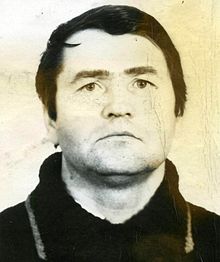
In 1948, the "Doctors' plot" was launched against a group of high-ranking Jewish doctors accused of conspiring and assassinating a number of Soviet leaders. In 1951-1952, a group of Jewish youth (junior high school students and schoolchildren) from the Union for the Struggle for the Revolution, who had formed a youth left-wing anti-Stalinist underground organization and criticized the current regime, were sentenced to death and long terms of imprisonment. On the eve and during the Second World War, political repression in the Red Army did not stop. Most of the servicemen were prosecuted on fabricated baseless allegations.[51] In 1949, before the celebration of the 70th anniversary of Stalin's anniversary, veterans and invalids of the Second World War were repressed in the USSR. Some of them were shot, others were taken to the distant islands of the North and to the remote corners of Siberia. Valaam is a well-known camp for World War II invalids located on the island of Valaam (northern part of Lake Ladoga), where war invalids were transported after World War II in 1950-1984.[52][53]
On January 12-14, 1972, the KGB of the Ukrainian SSR launched Operation Bloc, arresting a large group of Ukrainian dissidents: Vasyl Stus, Ivan Svitlychnyi, Yevhen Sverstiuk, Leonid Pliushch, Danylo Shumuk, Mykola Plakhotniuk, Zynovyi Antoniuk, Oles Serhiienko, Ivan Kovalenko, Viacheslav Chornovil, Mykhailo Osadchyi, Ivan Gel, Stefania Shabatura, Iryna Stasiv-Kalynets. On January 20, priest Vasyl Romaniuk (later Holiest Patriarch of Kyiv and all Ruthenia-Ukraine Volodymyr) and many other Ukrainian figures were arrested. A total of 100 people were arrested in Ukraine in 1972.[54] According to Lyudmila Alekseeva, in 1972-1974 more than 122 people were arrested for participating in the Ukrainian national democratic movement.[55]
Deportations
[edit]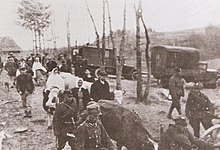
In 1944-1945, the deportation of the western Ukrainian population from the lands ceded to the Polish People's Republic began. There were 460,500 deported Ukrainians in Poland. During the resettlement, the bulk of them were planned to be sent to Eastern Ukraine (316,324 people, or 68.7% of the total number of deportees). Somewhat later, a total of 497,682 Ukrainians (125,949 families) were registered in the Polish People's Republic. By July 1946, 482,880 people had been evacuated. (122, 622 families), i.e. 97%. The eviction of Ukrainians from their original lands began on November 1, 1944 with the departure of the first echelon with the inhabitants of the village of Striltsi, Hrubieszów County. The echelon consisted of 28 cars that transported the first 78 farms of 290 people to the USSR. At the beginning, the majority of deportees went to the eastern regions. As of December 10, 1944, 81% of the deportees or 3,121 families out of 11,735 were sent to Zaporizhzhia, Odesa, Dnipropetrovsk, Kherson, and Mykolaiv oblasts. At the end of March 1945, 93.1% of deported or 19,796 families out of 71,839 people arrived in the above-mentioned oblasts, as well as in Poltava, Sumy, Stalin, Kirovohrad, Vinnytsia, and Kharkiv oblasts. Subsequently, the number of migrants to Eastern Ukraine was constantly decreasing. The "evacuees" were resettled throughout the Ukrainian SSR, but by the end of 1947 most people had settled in its western part and, in particular, in the Ternopil oblast. The vast majority of deportees found themselves in villages and only a small part of them was involved in industry.
April 28 — July 29, 1947 was Operation Vistula, which consisted in the forced, using the troops of the USSR, the Polish People's Republic, Czechoslovakia), deportation of Ukrainians from their ethnic territories — Lemkivshchyna, Nadsyannia, Podlachia and Kholmshchyna — in the territory of the western and northern parts of the Polish state, which until 1945 belonged to Germany, the "Recovered Territories" in order to assimilate the Ukrainian population under the manipulative pretext of limiting the support of the Ukrainian underground by the local population. The action was accompanied by mass violence against the Ukrainian population. 140,575 people were forcibly relocated, 3,936 people were imprisoned in the Jaworzno concentration camp, 655 people were killed, and 2,800 members of the Ukrainian OUN and UPA movement were arrested in Zakerzonnia. From April to July 1947, the Vistula Task Force conducted 357 hostilities, killed 1,509 Ukrainian insurgents, and destroyed 1,178 bunkers and hideouts.
Monument to the victims of Operation Vistula in the Beskidy Środkowe On October 21, 1947, the USSR government punished the UPA and forced the mass deportation of Operation West.[56] It was commanded by Deputy Minister of Internal Affairs of the USSR Nikalay Dyatlov. The operation involved: MGB operatives — 6859 people, armed forces (soldiers of the MGB internal troops and the MGB security corps, personnel of the Ministry of Internal Affairs and border troops, "jumps") — 46,509, Soviet partisans — 15,556, army drivers — 1,227 people.[19] During the operation used carts and vehicles, armored vehicles, tractors, railways. The deportation covered Volyn, then Drohobych and Stanislav, Lviv, Rivne, Ternopil and Chernivtsi oblasts. 28 November 1947 Affairs of the USSR S. Kruglov sent to the Deputy Chairman of the Council of Ministers of the USSR L. Beria notification of the resettlement of 26,460 families (76,268 people) of "active nationalists and bandits" from the western regions of Ukraine. 21,197 families (61,066 people) to work in the coal industry of the eastern regions of the USSR, the other 5,264 families (15,202 people) in the Omsk oblast.
On December 22, 2016, the Verkhovna Rada of Ukraine adopted Resolution № 1807 on the commemoration of memorable dates and anniversaries in 2017, according to which October 21, 2017 commemorates the 70th anniversary of the mass deportation of the population of Western Ukraine to Siberia.[57]
The Holodomor of 1946—1947
[edit]
The state of agriculture after the Second World War was very difficult. About 30,000 Kolkhoz, Sovkhoz and MTS, thousands of villages were looted and destroyed, of which more than 250 suffered the fate of Koriukivka. Livestock has fallen sharply and tractor and combine fleets have been severely damaged.[58] Thus, in 1946, 350 thousand tons of grain were exported from the USSR to the Kingdom of Romania, in 1947 — 600 thousand tons of grain — to the Czechoslovak Republic, in those two years the Polish People's Republic received from the Soviet Union 900 thousand tons of bread.[59] And in the Moldavian SSR and the southern regions of the Ukrainian SSR, famine spread rapidly, and in the first half of 1947 alone, 130 cases of cannibalism were officially registered.[60]
On January 7, the Ministry of State Security of the Ukrainian SSR informed the State Security Service of the USSR and the Central Committee of the Communist Party of Ukraine about the difficult food condition of collective farms in the Kirovohrad Oblast. Approximately 1,223 families had no food and were depleted with signs of dystrophy. Families of collective farmers killed at the front, large families, families of invalids of the Second World War of Chervonokamiansk, Oleksandriia, Pishchano-Brodsk, Ustynivka, Pidvysotsky, Novoheorhiivsk, Velykovysk and Dobrovelychkivka Raion were especially affected. On February 17, the Regional Department of the Ministry of Internal Affairs of the Izmail Oblast reported to the Ministry of Internal Affairs of the Ukrainian SSR on food difficulties and cannibalism in the region. Malnutrition and dystrophy have increased as a result of malnutrition. In January 1947, 4,533 people died in the region, 1,258 were born. Of the dead, 1,568 died of dystrophy. During the first decade of February 1947, 2,625 people died, including 978 from dystrophy. There were approximately 16,000 patients with dystrophy in the region. Particularly high mortality was observed in Novoivanivskyi and Bolhrad Raion. During January-February 1947, cases of cannibalism were detected.[61]
On August 21, 1946, the agricultural department of the Central Committee of the CP (b) U informed the Central Committee of the CP (b) U about measures to combat the transportation of bread from the western regions of Ukraine. It was noted that the transport police of the USSR in connection with the resolution of the Council of Ministers of the RSFSR of July 31, 1946 banning the sale of grain on the market by collective farms, collective farmers and individuals until they fulfill the plan of grain harvest from 1945-1946 organized at major railway stations Ukrainian SSR operational barricading detachments that fought with the sale and purchase of grain and flour in the markets. In June, the transport police of the Ukrainian SSR removed from freight trains 62.4 thousand people who traveled to Western Ukraine for bread. In the last two decades of July, 97633 people were fired.[62]
Thus, for the Ukrainian SSR, the grain procurement plan was increased to 362 million 750 thousand poods.[63] Despite the rigid action of the vertical: center—republic—region—district—village council — collective farm, the activities of the party-command apparatus, tens of thousands of special commissioners for grain procurement, grain in the state "pantry" did not arrive at the rate expected by the center.[64]
The worst famine was in the winter and spring of 1947, which turned into a famine. On February 6, 1947, the MGB of the USSR reported to the MGB of the USSR about cases of cannibalism and cannibalism in the Dnipropetrovsk and Izmail oblast. On February 25, the State Security Committee of the Ukrainian SSR reported that in two months of 1947, 16 cases of eating human corpses were recorded, including 13 cases in the Izmail oblast.[65] People of different nationalities — Ukrainians, Russians, Jews, Bulgarians, Gagauz, and others — suffered and died in the villages and cities of the Ukrainian SSR. According to incomplete data, more than 1 million people died of artificial man-made starvation in the Ukrainian SSR. The totalitarian government silenced the famine.
Persecution of religion
[edit]When Ukraine was reoccupied by Soviet troops in 1944-1945, the priests of the Ukrainian Autocephalous Orthodox Church who remained in Ukraine were repressed and destroyed. Many bishops, fleeing persecution, moved to West Germany, then to the United States, Canada, and other countries, where they headed various jurisdictions.
On April 11, 1945, Soviet authorities arrested Archbishop Josyf Slipyi, and later repressed all other bishops of the Ukrainian Greek Catholic Church. In May 1945, the "Initiative Group for the Reunification of the Greek Catholic Church with the Orthodox Church" was formed, and Nikita Khrushchev personally reported to Joseph Stalin on its work. In March 1946, a pseudo-council took place in Lviv, at which the liquidation of the UGCC was proclaimed, and a significant part of its property was transferred to the Moscow Patriarchate. In 1946-1989, the UGCC was forced to operate underground.
In 1964, the Institute of Scientific Atheism was established. In 1965, the RSRPC and the SDRK were merged into the Council for the Affairs of Religious Cults under the USSR Council of Ministers, and the provisions on the SSR were published for the first time. The council had the right to decide for itself on the registration and deregistration of religious associations, on the opening and closing of houses of worship, and to inspect the activities of religious organizations.
The USSR Constitution of 1977 preserved the de facto inequality of citizens depending on their attitude to religion: atheists could freely propagate their beliefs, and believers had only the right to "practice religious cults" (Article 52). The spread of "scientific atheism" with a Marxist backing was made obligatory for teachers in schools and universities, and there were regular positions of propagandists in local party committees. However, in the absence of ideological competition, the level of training of such personnel was low.
In the first years of Gorbachev's rule (1985-1987), the official attitude of the Soviet state to religion remained cool. In particular, on November 24, 1986, during a visit to Tashkent, Gorbachev called for a resolute struggle against religiosity. However, as the processes of "perestroika" develop, there is a gradual revision of the state's religious policy, a transition from atheistic propaganda to cooperation with religious organizations. The most significant changes began in 1988-1989. In 1988, the Council for Religious Affairs under the Council of Ministers of the USSR abolished the rule that prayer buildings are the property of the state.
The process of revival of the UGCC began with the meeting of Pope John Paul II with the President of the USSR Mikhail Gorbachev. Unfortunately, however, the early 1990s were marked by interfaith confrontation amid property disputes, complicated by a split within Ukrainian Orthodoxy.
On October 22, 1989, at the Council of Priests and Laity in Lviv, the revival of the Ukrainian Autocephalous Orthodox Church was proclaimed. The revived Church was headed by Ivan Bodnarchuk, a freelance bishop of the Moscow Patriarchate. On October 2, 1990, the Ukrainian authorities officially registered the UAOC.
In 1990, the USSR Law "On Freedom of Conscience and Religious Organizations" was adopted, which radically changed the nature of relations between the state and religious organizations. Article 5 of this law terminated state support for atheism, stating that "the state does not finance the activities of religious organizations and activities to promote atheism." The law gave religious organizations legal personality and allowed them to have international contacts without government mediation.
Russification
[edit]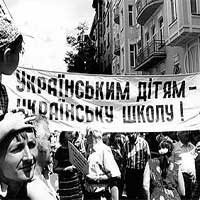
Deresufication of Ukraine began with the revolution of 1917 and the revival of Ukrainian statehood with the establishment of the Ukrainian People's Republic, was interrupted by the occupation of Ukraine by Soviet troops in 1919-1920. The establishment of Soviet power restored the dominance of Russians in Ukraine,[66] which manifested itself in particular in the dominance of the Russian language. Records of party and state institutions were kept in Russian; it also published most of the official bodies of the press, decrees, appeals, and so on. The book production of 1919–1923 was predominantly Russian.[67]
In 1933, a orthography reform took place that abolished the Ukrainian orthography of 1928 and in a hysterical atmosphere artificially brought the Ukrainian language, as well as the Belarusian language (see Narkamaŭka), into Russian in order to "fight nationalism on the language front." For example, the ancient grammatical form of the dual was banned as "archaic form and provincialism",[68] even scientific articles were written about it and the ending -и in feminine nouns of the III declension in the genitive singular, which was very important, because it allows to distinguish genitive case from dative and local. So wrote the Ukrainian classics:[69]
| “ | Поет не боїться від ворога смерти, Бо вільная пісня не може умерти | ” |
| — Lesia Ukrainka | ||
In 1938 the resolution of the CPC of the USSR and the Central Committee of the CPSU (b) "On the compulsory study of the Russian language in the schools of national republics and regions" was issued. There were no direct instructions in this resolution about any special privileges for the Russian language, but the implementation of this resolution in practice in different regions of the USSR led to a gradual restriction of the spheres of functioning of local national languages of different peoples of the USSR.[70]
Russification, especially intensified in the 1940s and 1950s (particularly in the western Ukrainian lands annexed to the USSR[71][72][73][74][75]), provoked a resistance movement from the early 1960s that encompassed certain circles of the Ukrainian intelligentsia and, in part, the workers. At that time, demands were made to teach in Ukrainian in all higher and secondary special schools and education in all preschools, to transfer to Ukrainian office work in institutions and enterprises, railways, trade and increase the number of publications of the USSR Academy of Sciences, universities and publishers in Ukrainian, as well as Ukrainian films. However, the response to these demands was the intensification of repressions against resistance activists, and in the USSR the "powerful and well-established mechanism of Russification" continued to operate (I. Dziuba). All affairs of party, state and public life, all spheres of economic life and their office work, higher, secondary technical and professional education were conducted in Russian. In Kyiv and other large cities of Ukraine, Ukrainian-language schools were few, with 20% of children enrolled. The same situation was in cultural and educational work. One of the main factors of Russification remained the Soviet army.
Opponents or adversaries of Russification and even its critics have been subjected to administrative and judicial repression: dismissal, imprisonment in prisons and concentration camps, exile. The main purpose of Russification was to create a single so-called Soviet people with a Russian language and culture. The initiators and propagandists of Russification in the USSR were party and Soviet figures of the Ukrainian family, who, guided by the motives of careerism and servitude, became enemies of their own people in leading positions in the party-government hierarchy (Kravtsev, Malanchuk, Bilodid, Skaba, etc.).
Resistance of Ukrainians to the Soviet regime
[edit]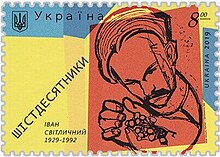
In the 1960s and 1970s, a generation of Ukrainian national intelligentsia was formed that was an internal moral opposition to the Soviet totalitarian state regime the Sixtiers (political prisoners and "prisoners of conscience," dissidents).[76] Their movement clearly lasted only a decade. Even in 1962, at a specially convened meeting of the creative intelligentsia with the leadership of the state, they were sharply criticized. After the internal coup in the CPSU in 1964, the pressure of state censorship on the intelligentsia sharply increased, and when the resolution of the Central Committee of the CPSU "On Censorship" was issued and the Soviet troops were introduced into Czechoslovakia, the CPSU set out to restore totalitarianism. The Sixtiers developed an active cultural activity that went beyond the official: they organized informal literary readings and art exhibitions, evenings in memory of repressed artists, staged silent plays, and composed petitions in defense of Ukrainian culture. Cultural activities, which did not fit into the framework of what was allowed, caused dissatisfaction of the authorities.[77]
During the "thaw", the authorities fought against the Sixtiers, as such an environment contributed to the formation of political opposition, which was not allowed in the USSR. In the Ukrainian cultural and educational movement, samizdat became more and more widespread, and publications of the Ukrainian diaspora were widely distributed.[78] In 1972, the Dobosh Case was falsified in Ukraine. On January 12-14, 1972, the KGB of the Ukrainian SSR launched Operation Bloc. During the year, about a hundred people were arrested, thousands were searched, tens of thousands of people were interrogated, and the most active Sixtiers were fired from their jobs or universities.[79] After the suppression of the Ukrainian revival in the 1960s, the authorities introduced a policy of eliminating linguistic, cultural and historical national identity in Ukraine. The Ukrainian-language system of education, newspapers and magazines were gradually supplanted. Political purges were carried out regularly.[80]
When the USSR signed the Helsinki Accords, dissidents organized open and, in their view, legally sanctioned groups whose task was to oversee the Kremlin's observance of civil rights.[81] He headed the Ukrainian Helsinki Group, writer Mykola Rudenko, a political commissar during World War II and a former party official in the writers' organization. The activities of the Ukrainian Helsinki Group testified to the transition of the dissident movement to a new, more mature stage with an established organizational structure and political program. The main new point of this program was the transition of Ukrainian dissidents to independent positions. The documents of the dissident movement increasingly called for Ukraine's secession from the USSR and the creation of an independent democratic Ukrainian state. After the group resumed its activities in 1988, the Ukrainian Republican Party was established on its basis in 1990.[82]
The Chornobyl disaster
[edit]On April 26, 1986, due to tests at the Chernobyl nuclear power plant, errors in the design of the station itself and construction, ignoring the problems that arose at the station, the Chernobyl disaster occurred. On May 1, a parade was held in Kyiv, and the Kremlin forced the leaders of the Ukrainian SSR to hold it so as not to cause panic.[83]
After assessing the extent of radioactive contamination, an evacuation was planned, but it was detained by the decision of the USSR government and the Central Committee of the CPSU.[84] The Chernobyl catastrophe had a great impact on socio-political life, some call it the beginning of the end of the Soviet Union.
Restoration of independence
[edit]On July 16, 1990, the Verkhovna Rada adopted the Declaration of State Sovereignty of Ukraine.
On October 2-17, 1990, the Revolution on Granite took place in Ukraine, the main purpose of the action was to prevent the signing of a new union treaty of the USSR. The demands of the students were satisfied by signing a resolution of the Verkhovna Rada, which guaranteed their implementation.[85]
After the failure of the August coup, on August 24, 1991, the Verkhovna Rada of Ukraine adopted the Declaration of Independence of Ukraine. The text of the act was written and proclaimed by Levko Lukianenko. The Ukrainian Soviet Socialist Republic ceased to exist, and modern Ukraine appeared on the geopolitical map of the world.
According to the results of the All-Ukrainian referendum of 1991, 90.32% of Ukrainian citizens voted for the Act of Independence of Ukraine,[86] and the first President of Ukraine was elected, who became Leonid Kravchuk. The day after the referendum, Ukraine was recognized by Canada and Poland, and by the end of January 1992, by 91 states.
On December 8, in Białowieża Forest, President of Ukraine Leonid Kravchuk, President of the RSFSR Borys Yeltsin and Chairman of the Supreme Council of the Republic of Belarus Stanislaŭ Šuškievič signed an agreement on the establishment of the Commonwealth of Independent States. But the Verkhovna Rada of Ukraine did not ratify the accession, ie it was not a member of the CIS. Although it had associate membership, terminated in 2018 by decree of President of Ukraine Petro Poroshenko.[87] On January 25, 1991, the President of the USSR, Mikhail Gorbachev, resigned, and the fact of the dissolution of the Union of Soviet Socialist Republics was definitively stated.
State succession of Ukraine
[edit]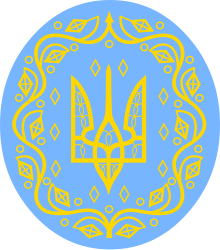
At present, modern Ukraine is legally defined in the Declaration of State Sovereignty of Ukraine of July 16, 1990 and in the Law of Ukraine of September 12, 1991 "On Succession"[88] as the successor of the UkrSSR. After 1991, there were legislative initiatives to change this succession to the UPR in order to restore historical justice. Also, some documents contain informal definitions that directly or indirectly proclaim the succession of Ukraine from other states of the Ukrainian people: Kyivan Rus, the Kingdom of Ruthenia, the Cossack Hetmanate and the Ukrainian People's Republic. The informality of such succession is also confirmed by the transfer by the President of the Ukrainian People's Republic in exile Mykola Plaviuk on January 22, 1992 of jewels to the newly elected President of Ukraine Leonid Kravchuk and the resignation of the President of the Ukrainian People's Republic.[89] This event is currently considered symbolic, as it had no legal consequences, although Kravchuk assured the UPR delegation that regulations for the use of state symbols would be developed soon, and, importantly, stressed:
| “ | This act should remind everyone that Ukraine has its pedigree, its political, state biography from historical times, which give strength and greatness to our people – from the times of Kyivan Rus, the Cossack Hetmanate state and the Ukrainian People's Republic. | ” |
| — Leonid Kravchuk | ||
On January 22, 2018, in the events dedicated to the 100th anniversary of the proclamation of independence of the Ukrainian People's Republic, the 5th President of Ukraine Petro Poroshenko during his speeches repeatedly emphasized the heredity of the state tradition.[90][91]
| “ | Modern Ukraine is the heir of centuries-old state and national traditions, revived during and as a result of the Ukrainian Revolution of 1917-1921. The idea of state independence, put on the agenda and hardened during the Revolution, became a powerful material force. It determined the entire further course of Ukraine's history | ” |
| — Petro Poroshenko | ||
On the same day, a group of deputies submitted to the Verkhovna Rada of Ukraine the draft law №7521 "On Succession of Ukraine in Relation to the Ukrainian People's Republic". The essence of this document comes down to the fact that the modern Ukrainian state must declare itself the successor of the UPR, and not the UkrSSR, as it is formally now, with all the ensuing consequences.[92][93][94]
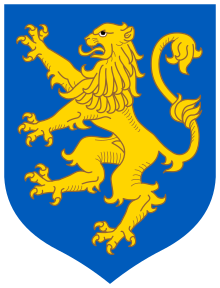
On October 3, 2019, the Verkhovna Rada of Ukraine registered a draft resolution proposing to postpone the date of Independence Day celebration to the date of proclamation of the IV Universal of the Central Council of Ukraine — January 22, and leave August 24 as a day off, renaming it Independence Day of Ukraine. According to People's Deputy Oksana Savchuk, the celebration of Independence Day should be postponed to January 22 — the day of the proclamation in 1918 of the IV Universal. In addition, the date of the proclamation of independence of the UPR coincides with the Day of Unity, when on January 22, 1919 the unification of the Ukrainian People’s Republic and the Western Ukrainian People’s Republic took place.
Interestingly, the Urainian Center for Educational Quality Assessment in the External independent evaluation program on the history of Ukraine points to the event of August 24 as the restoration of Ukraine's independence. (30 topics, page 33)[95]
Aftermath
[edit]Czech Republic
[edit]Operation Danube
[edit]In an interview with the British daily, which was interested in the attitude of today's Czech communists to the events of 50 years ago, the chairman of the Communist Party of the Czech Republic and Moravia (CPCM) Vojtech Filip said:[96]
| “ | The story was falsified one hundred percent. Nobody writes that this whole idea is put on an anti-Moscow position. At that time, the Politburo of the Soviet Union had only one pure Russian, and he voted against the invasion. Brezhnev was from Ukraine. The main force of the invading army were the Ukrainians! | ” |
| — Vojtěch Filip | ||
These words provoked a stormy reaction in Czech society, especially against the background of preparations for the honoring the memory of the 50th anniversary of the Soviet occupation of Czechoslovakia, which took place next week. So when Czech Radio asked the Communist leader for clarification, he clarified that allegedly:[97]
| “ | All countries of the former Soviet Union, including the Baltic States and Ukraine, are morally responsible for the Warsaw Pact invasion. | ” |
| — Vojtěch Filip | ||
According to Filip, today's Russia is not responsible for the actions of the USSR, and those who believe otherwise are simply based on their own anti-Russian position, and not on historical facts, which, according to the Czech communist, are "totally falsified."
Czech historian Petr Blažek of the Institute for the Study of Totalitarian Regimes says the Czech Communist leader is trying to confuse the situation:[98]
| “ | The Soviet bloc was then led by the Soviet Union. The principle of the communist system is centralization. It's like in the army: it doesn't matter who is of what nationality, because the whole system was based on the communist nomenklatura. It is absurd to accuse Ukraine and the Baltic countries of the actions of the Soviet Union, because they themselves were victims of the Soviet occupation. These were the occupied countries - the Baltic countries had been occupied by the Soviet Union since 1939, and Ukraine – since the 1920s. This is absurd! Wojciech Philipp uses the same logic as those who speak of "Polish death camps" instead of saying "Nazi death camps." This is just absurd. | ” |
| — Petr Blažek | ||
The Embassy of Ukraine in the Czech Republic is confident that this is being done at the request of the Russian leadership: "It is clear that this attempt was made at the behest of the Kremlin right now so that it could absolve itself of responsibility for its crimes at a time when the Czechs and Slovaks are commemorate the 50th anniversary of the great tragedy of both nations.", – said in a statement by the Embassy of Ukraine in the Czech Republic.[99]
Republic of Belarus
[edit]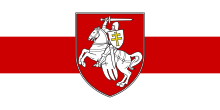
On October 3, 2020, the Belarusian state TV channel STB ("Сталічнае тэлебачаньне" / "Staličnaje telebačańnie") signed Ukraine as the "former Ukrainian Soviet Socialist Republic",[100] which caused outrage in Ukrainian society. The reason for this political provocation is the deterioration of relations between the Alaksandar Łukašenka regime and Ukraine after the Ukrainian authorities condemned the rigging of the presidential elections in Belarus in 2020, their results and the self-proclamation of President Alaksandar Łukašenka and the suppression of protests in Belarus.
In addition, the state TV channel has prepared a story about Lithuanians who are interested in the expenses of the Belarusian opposition Svetlana Tikhanovsky, who lives "in the best hotel in the country" and not in the center for refugees. In this case, Lithuania was referred to as the "former Soviet Republic of Lithuania." Another plot of the program is dedicated to Poland, which was signed as the "former Polish People's Republic". It addresses issues of violation of children's rights.[101]
Russian Federation
[edit]The leadership of the Russian Federation does not recognize the occupation of the territories of the former Russian Empire, after the collapse of which nation-states were formed. Russia's official position is that all territories, or rather puppet states, have voluntarily joined the USSR.[102][103][104]
In an interview in June 2021, Vladimir Putin criticized Ukraine accession to NATO,[105][58] saying that Ukrainians are one nation with Russians, and modern Ukraine is a Soviet-Bolsheviks entity:[106]
| “ | It is worth recalling how Ukraine emerged as a state. This is a product of the Soviet period. The Bolsheviks created the Soviet Union, in particular the Federal Republics and Ukraine. It may be recalled that these territories became part of the Moscovite state or the process of their reunification with Russia began in 1654 after the Pereiaslav Council. Then those people who lived in this area — those people considered themselves and called themselves Russians. Perhaps I will prepare a separate article on this topic. I'll think about it. | ” |
| — Vladimir Putin | ||
Of course, given the millennial statehood of Ukraine, namely Kyivan Rus, the Kingdom of Ruthenia, the Zaporozhian Sich, the Cossack Hetmanate and the Ukrainian People's Republic, these allegations are part of Russian propaganda for domestic use. As for the Ukrainian ethnonym, until the XX century, Ukrainians used the name Rus (руси, rusy), Rusyn (русини, rusyny), Cossacks (козаки, kozaky), and in the West, Ukrainians were called Ruthenians or Ruthenes (рутени, ruteny). However, neither Russians nor Moscovites. In addition, the President of Russia called the Pereiaslav Council "Yaroslav Council".[107]
On July 12, 2021, a scandalous article "On the historical unity of Russians and Ukrainians" was published on the website of the President of the Russian Federation in Russian and even in Ukrainian.[108] The article has been included as one of the mandatory topics in military-political training in the Russian army.[109]
According to a poll conducted by the Razumkov Center, even voters of the pro-Russian Opposition Platform — For Life disagree with Putin's thesis that there was and could be no historical basis for the idea of a separate Ukrainians from Russians, and the separation of Ukrainians and Belarusians as separate nations, because it was the result of Soviet national policy.[110] Only 12.5% of Ukrainian citizens agree with the theses of the President of the Russian Federation, 70% disagree, and another 17% are undecided.[111] According to political scientists, Vladimir Putin's article "On the historical unity of Russians and Ukrainians" is addressed not to Ukrainians but to world leaders as a demonstration that Russia as the successor to the Soviet Union intends to regain control over Ukraine.[112]
Ukraine
[edit]As of 2001, a total of 307,450 archival criminal and investigative cases had been completed and the number of prosecuted victims of illegal repression had been completed. According to them, 248,710 people were rehabilitated, 117,243 people were denied rehabilitation in accordance with the current legislation of Ukraine. By January 1, 1998 alone, the prosecutor's office had considered 122.8 thousand applications from citizens for rehabilitation. In total, up to 440 thousand people were rehabilitated in Ukraine (132 thousand of them during the "Khrushchev thaw"). As part of the state policy of remembrance, the official commemoration of the victims of political repressions (Holodomor Remembrance Day and political repressions) was first introduced by the decree of the President of Ukraine of October 31, 2000 № 1181.
In 2003, the Museum of Soviet Occupation was established in Kyiv, which displays the crimes of the communist regime in the period 1917–1991 in Ukraine. The purpose of the museum is to inform the Ukrainian and world community about the still little-known pages of the tragic history of Ukraine during the communist period. There is also an open-air museum of Soviet occupation in Kyiv.[113]
The Decree of the President of Ukraine of May 21, 2007 № 431 established the annual celebration of the Day of Remembrance of Victims of Political Repressions on the third Sunday of May "in order to properly honor the memory of victims of political repressions, to draw public attention to tragic events in Ukraine caused by violence. communist ideology, the revival of national memory, the assertion of intolerance to any manifestations of violence against humanity. "
Of particular importance for the consolidation in the national memory is the identification and memorialization of the relevant places of memory — places of mass executions and burial of victims. As of 2010, at least 18 mass graves of victims of political repressions have been identified in Ukraine.
In 2015, Ukraine condemned the crimes of the communist totalitarian regime with the Law "On Condemnation of the Communist and National Socialist (Nazi) Totalitarian Regimes in Ukraine and Prohibition of Propaganda of Their Symbols."[114]
Volodymyr Viatrovych, director of the Ukrainian Institute of National Memory, said in 2016 that Ukrainians should talk about the Soviet occupation. In 2016, he affirmed that the Soviet period of Ukrainian history was an occupation, and in his opinion, Ukraine should declare that it was the successor of the Ukrainian People's Republic, which existed in 1917-1921. It was noted that the Act of Independence of Ukraine of 1991 should be considered as the restoration of Ukraine's independence by Estonia, Latvia and Lithuania. These states are celebrating their independence days, starting in 1918, not 1990-1991.[115][116]
| “ | When we talk about the basis of Soviet power in Ukraine, we must understand that in Ukraine it was established by force, it was exported from outside. It is important for us to say that the Ukrainian state is not something accidental that appeared in 1991. The Ukrainian state — this is a long-term result of the struggle of Ukrainians for their independence | ” |
| — Volodymyr Viatrovych | ||
See also
[edit]- Territories of Poland annexed by the Soviet Union
- Occupation of the Baltic states
- Soviet occupation of the Baltic states (1940)
- Soviet occupation of Latvia in 1940
- Soviet occupation of the Baltic states (1944)
- Soviet re-occupation of Latvia in 1944
References
[edit]Citations
[edit]- ^ "Радянська окупація (1939-1941)". Інтерактивний Львів.
- ^ David James Smith, Estonia: independence and European integration, Routledge, 2001, ISBN 0-415-26728-5, pXIX
- ^ Parrott, Bruce (1995). "Reversing Soviet Military Occupation". State building and military power in Russia and the new states of Eurasia. M.E. Sharpe. pp. 112–115. ISBN 1-56324-360-1.
- ^ Gennady Charodeyev, Russia Rejects Latvia's Territorial Claim, Izvestia, (CDPSP, Vol XLIV, No 12.), 20 March 1992, p.3
- ^ Велика війна 1914—1918 pp. і Україна. У двох книгах. Книга 1. Історичні нариси.— К.: TOB «Видавництво „КЛІО“», 2014.— С. 670—671.
- ^ Incognita, Газета День, День, всеукраїнська газета, історичний сайт, Ukraina Incognita, Україна. "Ратні дороги отамана Зеленого - Україна Incognita". incognita.day.kiev.ua. Retrieved 2017-09-16.
{{cite web}}: CS1 maint: multiple names: authors list (link) - ^ "Четвертий Універсал Української Центральної Ради — Вікіджерела". uk.wikisource.org.
- ^ "Доценко Олександер — Зимовий похід (6.XII.1919 — 6.V.1920). — К.: Видавництво ім. О.Теліги, 2001. — 376 с." (PDF). Archived from the original (PDF) on 20 November 2015. Retrieved 2 November 2015.
- ^ a b "Забуте свято. 6 липня 1923 року - день народження СРСР". Історична правда.
- ^ a b "Владимир БУТКЕВИЧ. Была ли УКРАИНА действительно связана СОЮЗНЫМ ДОГОВОРОМ 1922 года?". Archived from the original on 21 May 2012. Retrieved 20 May 2012.
{{cite web}}:|archive-date=/|archive-url=timestamp mismatch; 21 April 2012 suggested (help) - ^ a b "Союз, которого не было. Почему СССР оказался фантомом". ФОКУС. February 1, 2018.
- ^ a b Литвин Микола, ЗУНР і Галицька СРР у геостратегії більшовицької Росії // Україна: культурна спадщина, національна свідомість, державність. 18/2009. — С. 101—118.
- ^ Геннадій Єфіменко (20 September 2017). "Цей день в історії : 21 вересня : Падіння Галицької СРР".
- ^ (in Russian).
{{cite book}}: Missing or empty|title=(help) - ^ Російський державний військовий архів. — Ф. 9. — Оп. 39. — Спр. 73. — Арк. 244.
- ^ "Закон про прийняття Західної України до складу Української Радянської Соціалістичної Республіки (15 листопада 1939 р.)". Підручники онлайн. Archived from the original on 2013-07-16. Retrieved 2013-05-20.
- ^ Олег Романів, Інна Федущак.
{{cite book}}: Missing or empty|title=(help) - ^ Ультимативная нота советского правительства румынскому правительству 26 июня 1940 г. файл формату rtf Archived 1 February 2014 at the Wayback Machine
- ^ a b c Зарубін (2008). Без переможців. З історії Громадянської війни в Криму. ISBN 9789662930474.
- ^ Крип'якевич Іван Історія українського війська. — Львів, 1936. — с. 418
- ^ Савченко В. А. Первая война большевиков против Украинской Народной Республики (декабрь 1917 — февраль 1918) / Двенадцать войн за Украину. — Харьков: Фолио, 2006. — 415 с. — ISBN 966-03-2921-0. (in Russian)
- ^ В. Я. Ревегук. Повстанський рух на Полтавщині. Червоний терор
- ^ С. П. Мельгунов. «Красный террор» в Россіи 1918 — 1923
- ^ a b П. Губа. Періодична преса про погроми в період української революції (1917—1920 рр.)
- ^ Рідне слово. — 1919. — 30 September.
- ^ Страхіття Харківської ЧК // Шлях. — 1919. — 3 жовтня.
- ^ Страхіття Харківської ЧК // Шлях. — 1919. — 9 жовтня.
- ^ Трудова громада (Кам'янець-Подільський). — 1920. — 18 лютого
- ^ Лановик Б. Д., Матисякевич 3. М., Матейко Р. М. Економічна історія України і світу: Підручник / За ред. Б. Д. Лановика. — К.: Вікар, 1999. ISBN 966-7131-20-3 — 737 с.
- ^ Україна-Польща важкі питання. — Т. 5./ Ред. Є. Місило. Світовий союз воїнів Армії Крайової; Об'єднання українців у Польщі. — Варшава, 2001. — с. 20.
- ^ В. Парсаданова. Депортація населення із Західної України і Західної Білорусії в 1939—1941 рр. — Нова і новітня історія. — 1990. — № 2. — с. 32.
- ^ a b Стяжкіна Олена. Рокада: чотири нариси з історії Другої Світової. — К.: Дух і Літера, 2020. — с. 89-104. ISBN 978-966-378-764-0
- ^ a b c Матеріали до української етнології: зб. наук. пр. — Київ: (б. в.), 2007. — Вип. 6 (9). — с. 106.
- ^ Iwan Samijłenko тло голодового геноциду в Україні. — Київ: Просвіта, 1998. — С.16.
- ^ Інститут історії України (12 травня)
- ^ http://www.history.org.ua/?hrono&inyear=1919
- ^ Volodymyr Serhiychuk. Голод 1921—1923 років Archived 28 December 2008 at the Wayback Machine
- ^ "Джерело фотографії «Жертви голоду на вулицях Харкова»". Archived from the original on 1 September 2010. Retrieved 13 September 2010.
- ^ Улянич Володимир Іванович Терор голодом і повстанська боротьба проти геноциду українців у 1921—1933 роках. — К.: МАУП, 2004. — 84 с.
- ^ "Украина (Украинская Республика)... Независимая Народная Республика провозглашена в 1918, завоевана Красной армией в 1920" Украина / Лидин Р. (ред.). Краткий энциклопедический словарь — М.: «ООО Издательство АСТ», ООО «Издательство Астрель», 2002. — 1136 с. (С. 954—955.)
- ^ Марочко В. Голодомор 1932—1933 років в Україні: Хроніка. — К. : Вид. дім «Києво-Могилянська академія», 2008. — 294 с. — С. 135.
- ^ № 116. ПОСТАНОВА ПОЛІТБЮРО ЦК КП(б)У ТА РАДНАРКОМУ УСРР ПРО ЗАНЕСЕННЯ НА «ЧОРНУ ДОШКУ» СІЛ, ЯКІ ЗЛІСНО САБОТУЮТЬ ХЛІБОЗАГОТІВЛІ. 6 грудня 1932 р. Archived 2012-08-15 at the Wayback Machine // Голод 1932—1933 років на Україні: очима істориків, мовою документів / Кер. кол. упоряд. Р. Я. Пиріг. — К.: Політвидав України, 1990. — 605 с. — Офіційний веб-портал Державна архівна служба України
- ^ Марочко В. Голодомор 1932—1933 років в Україні: Хроніка. — К. : Вид. дім «Києво-Могилянська академія», 2008. — 294 с. — С. 169.
- ^ Улянич Володимир. Терор голодом і повстанська боротьба проти геноциду українців у 1921—1933 роках. — К.: МАУП, 2004. — 84 с. — С. 69.
- ^ "Василенко В. Голодомор 1932—1933 років в Україні як злочин геноциду: правова оцінка. — К.: Вид-во імені Олени Теліги, 2009. — 48 с. — ISBN 978-966-355-027-5. ст. 31" (PDF). Archived (PDF) from the original on 8 April 2017. Retrieved 8 April 2017.
- ^ "Дзеркало тижня. № 46 (774) 28 листопада — 4 грудня 2009. «Тінь Голодомору над західними українцями». Автор: Роман Якель". Archived from the original on 15 December 2009. Retrieved 24 December 2009.
- ^ "Міжнародна науково-практична конференція «Голодомор 1932—1933 років: втрати української нації» — Освіта і наука". memorialholodomor.org.ua. Archived from the original on 2017-11-19. Retrieved 2018-01-18.
- ^ Червоний ренесанс. Фільм третій: Безодня (1930—1934). — Contact (studio). 2004. — 12:06/51:33.
- ^ "Была ли безбожная пятилетка?". nvo.ng.ru (in Російською). Retrieved 2019-08-09.
{{cite web}}: CS1 maint: unrecognized language (link) - ^ Organization of Ukrainian Nationalists and the Ukrainian Insurgent Army: Historical Essays (archive.org)
- ^ Мусієнко І. В. Політичні репресії проти буковинців і бессарабців у Червоній армії в 1941—1945 рр. // Питання історії України: Збірник наукових статей. — Чернівці: Золоті литаври, 1999. — Т.3. — С. 304—320.
- ^ http://www.khpg.org/index.php?id=1368537165 Як в СРСР знищували ветеранів інвалідів війни
- ^ http://www.ukurier.gov.ua/uk/articles/do-specinternativ-invalidiv-frontovikiv-zabirali-p/p/ «До спецінтернатів інвалідів-фронтовиків забирали прямо з вулиць»
- ^ Хроника текущих событий, вып. 28. — Нью-Йорк: «Хроника», 1974. — С. 18—24
- ^ Алексеева Л. История инакомыслия в СССР. Новейший период. — М.: ЗАО РИЦ «Зацепа», 2001. — С. 24
- ^ УКРАЇНА ВШАНОВУЄ ЖЕРТВ МАСОВОЇ ДЕПОРТАЦІЇ НАСЕЛЕННЯ ЗАХІДНИХ ОБЛАСТЕЙ 21 ЖОВТНЯ 1947 РОКУ, 5 канал, 21.10.2017
- ^ 21 ЖОВТНЯ — 70-ТІ РОКОВИНИ З ДНЯ МАСОВОЇ ДЕПОРТАЦІЇ НАСЕЛЕННЯ ЗАХІДНОЇ УКРАЇНИ ДО СИБІРУ
- ^ a b Голод в Україні. 1946—1947. Документи і матеріали. — К. — Нью-Йорк, 1996. — С. 156—157. ОЛЕГ РАБЕНЧУК
- ^ Волков И. М. Засуха, голод 1946—1947 годов // История СССР. — 1991. № 4. С. 3-19.
- ^ Alexandra Mikhailovna Veselova Післявоєнна трагедія: голод 1946—1947 рр. в Україні // Український історичний журнал. — 2006. № 6. С. 98-124.
- ^ Голод в Україні. 1946—1947. Документи і матеріали. — К. — Нью-Йорк, 1996. — С. 184. ОЛЕГ РАБЕНЧУК
- ^ Інститут історії України. Хронологія за 1946 рік.
- ^ Голод 1946—1947 років в УРСР. Стаття в Енциклопедії історії України: Т. 2: Г-Д / Редкол.: В. А. Смолій (голова) та ін. НАН України. Інститут історії України. — К.: «Наукова думка», 2004.
- ^ В. В. Коротенко, Т. П. Пустовіт Голод 1945—1947 років на Полтавщині. Висвітлення ходу хлібозаготівельної кампанії 1946—1947 років на шпальтах обласної газети «Зоря Полтавщини» Archived 2013-10-20 at the Wayback Machine
- ^ Інститут історії України. Хронологія за 1947 рік.
- ^ http://litopys.org.ua/sporl/sh03.htm
- ^ http://litopys.org.ua/ohukr/ohu.htm
- ^ ДВІ СЛОВІ ПРО ДВОЇНУ, Пам'ятки України: Історія та культура, № 1-2, 2001 р.
- ^ Блог Пономарева: чому я пишу «радости», а не «радості» — BBC News Україна
- ^ Русский язык в межнациональном общении
- ^ 1947. Каганович провів чистку серед діячів української культури. Депортація в Сибір населення Західної України. План вивезення українців у Сибір зірвався через нестачу вагонів.
- ^ "3 червня 1949 наказом міністра вищої освіти України кафедру історії УРСР у Львівському університеті було об'єднано з кафедрою історії СРСР". Archived from the original on 4 June 2011. Retrieved 26 February 2012.
- ^ Даниленко В. «Інтернаціоналізація» Радянської України[dead link]
- ^ «Досить активно ішов процес зросійщення в повоєнний період» [dead link]
- ^ Інтелігенція Львова в 1944 — 1953 роках
- ^ Енциклопедія українознавства. Т. 1–11
- ^ Ярослав Секо ІСТОРИЧНИЙ ДИСКУРС УКРАЇНСЬКИХ ШІСТДЕСЯТНИКІВ / Україна–Європа–Світ. Міжнародний збірник наукових праць. Серія: Історія, міжнародні відносини / Гол. ред. Л. М. Алексієвець. — Тернопіль: Вид-во ТНПУ ім. В. Гнатюка, 2010. — Вип. 5. У 2 ч.: Україна–Європа–Світ: історико-політичні та гуманітарні аспекти розвитку / Міжнародний збірник наукових праць на пошану проф. М. М. Алексієвця. — Ч. 1. — 373 с.
- ^ Перша хвиля арештів 1965 р. Дисидентський рух в Україні. Сайт учасників УГС та Харківської правозахисної групи.
- ^ Друга хвиля арештів 1972-73 рр.
- ^ Шістдесятники // Дисидентський рух в Україні. Сайт учасників УГС та Харківської правозахисної групи.
- ^ «Про специфіку руху опору 60-70 років»
- ^ Русначенко А. М. Національно-визвольний рух в Україні середина 1950-х — початок 1990-х років. — К., 1998.
- ^ Валентин Згурський: Правду про чорнобильську аварію в перші дні знали всього три людини: Горбачов, Рижков і я. Інтерв'ю 2013 року. Частини I—III, — Гордон, 27 жовтня 2016]
- ^ "Національна доповідь «20 років Чорнобильської катастрофи: погляд в майбутнє» (сторінка 8)" (PDF). Archived from the original (PDF) on 4 March 2016. Retrieved 26 April 2018.
- ^ Про розгляд вимог студентів, які проводять голодування … | від 17.10.1990 № 402-XII
- ^ "АКТ ПРОГОЛОШЕННЯ НЕЗАЛЕЖНОСТІ УКРАЇНИ". resource.history.org.ua. Retrieved 2019-07-29.
- ^ Порошенко опублікував указ про вихід України із міжнародних договорів СНД | Українська правда (pravda.com.ua)
- ^ "Про правонаступництво України". Офіційний вебпортал парламенту України.
- ^ "1992: The last president of the Ukrainian People's Republic handed Kravchuk jewels". www.istpravda.com.ua. Historical truth. 2012-01-22. Retrieved November 14, 2017.
- ^ "Today we are much stronger and united, hardened by a century of struggle, we rely on significant international support - the President at the opening of the exhibition "Ukrainian Circle" to the Day of Unity of Ukraine and the 100th anniversary of the proclamation of independence of the UPR". www.president.gov.ua. Administration of the President of Ukraine. 2018-01-22. Retrieved January 22, 2018.
- ^ "Speech by the President of Ukraine at a solemn meeting on the occasion of the Day of Unity of Ukraine and the 100th anniversary of the proclamation of independence of the Ukrainian People's Republic". www.president.gov.ua. Administration of the President of Ukraine. 2018-01-22. Retrieved January 22, 2018.
- ^ Oleh Bahan (2018-01-31). "Ukraine's succession to the UPR is the end of "legal" Ukrainophobia". www.vgolos.com.ua. Vholos. Retrieved February 6, 2018.
- ^ "Draft Law on Succession of Ukraine in Relation to the Ukrainian People's Republic". w1.c1.rada.gov.ua. Verkhovna Rada of Ukraine. 2018-01-22. Retrieved February 6, 2018.
- ^ Oleh Tiahnybok (2018-01-22). "Ukraine is the successor of the Ukrainian People's Republic. Draft law". blogs.pravda.com.ua. Ukrainska Pravda. Retrieved February 6, 2018.
- ^ UCEQA and restoration of independence of Ukraine
- ^ "Czech communists confront bitter legacy of Prague Spring". the Guardian. 2018-08-12. Retrieved 2021-06-08.
- ^ "Za invazi viňme všechny bývalé státy SSSR, dovysvětluje Filip. ‚Absurdní logika,' reaguje historik". iROZHLAS (in Czech). Retrieved 2021-06-08.
- ^ "«Україна була окупованою країною, а не окупантом» – чеський історик пояснює комуністам". Радіо Свобода.
- ^ "Log into Facebook". Facebook.
{{cite web}}: Cite uses generic title (help) - ^ "Держтелебачення Білорусі «перейменувало» Україну на «колишню УРСР»". www.ukrinform.ua.
- ^ "Білоруський державний телеканал підписав Україну «колишня УРСР»". babel.ua.
- ^ "Russia denies Baltic 'occupation'". 2005-05-05. Retrieved 2020-06-27.
- ^ "Kremlin fires back at critics". The New York Times. 2005-05-06. ISSN 0362-4331. Retrieved 2020-06-27.
- ^ Putin, Vladimir (2020-06-18). "Vladimir Putin: The Real Lessons of the 75th Anniversary of World War II". The National Interest. Retrieved 2020-06-27.
- ^ "Brussels Summit Communiqué issued by the Heads of State and Government participating in the meeting of the North Atlantic Council in Brussels 14 June 2021". NATO.
- ^ "Путін напише статтю з історії України. Порівняв проєкт Зеленського з нацистами" – via www.bbc.com.
- ^ Денисов, Сергій (June 10, 2021). "Путін допустив, що напише статтю з історії України і назвав Переяславську раду «Ярославською»". detector.media.
- ^ "Стаття Володимира Путіна «Про історичну єдність росіян та українців»". Президент России.
- ^ "Статья Путина об Украине стала обязательной для изучения в армии". Радио Свобода.
- ^ "З тезами зі статті Путіна не згодні навіть виборці ОПЗЖ – опитування". Слово і Діло.
- ^ Citizens' assessment of the main theses of Putin's article "On the historical unity of Russians and Ukrainians" (July-August 2021) (razumkov.org.ua)
- ^ "Стаття Путіна адресована не українцям, а світовим лідерам - політолог". Інтерфакс-Україна.
- ^ "В Києві з'явиться музей радянської окупації". KYIV CITY COUNCIL. July 23, 2015.
- ^ "LAW OF UKRAINE. On the condemnation of the communist and national socialist (Nazi) regimes, and prohibition of propaganda of their symbols | Офіційний веб-сайт УІНП". old.uinp.gov.ua.
- ^ "В'ятрович: Період радянської влади в Україні можна вважати окупацією". 5 канал.
- ^ "Перебування України у складі СРСР було окупацією, - В'ятрович". espreso.tv.
Further reading
[edit]- Soviet occupation of 1944-1991
- Alfiorov M. A. Urbanization processes in Ukraine in 1945–1991: Monograph / MA Alfiorov. — Donetsk: Donetsk branch of NTSh them. Shevchenko, LLC "Eastern Publishing House" 2012. — 552 p.
- Operation "West"
- Bazhan O. H. Dissident (opposition) movements of the 1960s and 1980s in Ukraine
- Deportations of Ukrainians and Poles: late 1939 — early 50's: (To the 50th anniversary of Operation Vistula): [Materials International. Science. konf.] / uporyad.: Yu. Slyvka; NAS of Ukraine. Inst. Of Ukrainian Studies. them. I. Krypiakevych. — L., 1998. — 132 p.


